Abstract
This article deals with the problems that arise during the evaluation of the surface of the components, which can have a fundamental impact on the functionality and service life of the component as well as the entire product. A fast method for estimating the condition and maximum error of the surface tester used for assessing the surface roughness of components was proposed. Using the secondary surface roughness standard, a uniform distribution law of the measured data was experimentally identified as a suitable model, according to which it is then possible to determine the coverage factor for determining the measurement uncertainty. The design of surface roughness measurement methodology for Ra determination is critical when selecting optimal settings of conditions and measurement parameters for various types of component surface treatment technologies. This is mainly due to the effect of the selection of the evaluation standard, the effect of the measurement speed, and the effect of setting the cut-off filter for the evaluation of the quantity Ra. Etalon samples of surface roughness realized by different technologies were used for experimental verification of these phenomena. Large sets of measurements were carried out on selected samples from each technology, and, accordingly, a methodology was proposed for determining the optimal number of measurements for determining the surface roughness of the investigated component, which represents an important factor for achieving measurement results with minimal measurement uncertainties at low financial costs.
1. Introduction
Surface roughness is a key parameter in many industrial devices and significantly affects the quality and equipment composed of several machined components; therefore, reliable measurement of surface roughness plays a fundamental role in ensuring the functionality and reliability of the final product. However, the measurement of surface roughness is not without problems, especially when it comes to quantifying the uncertainty associated with these measurements. This estimate of uncertainty is necessary to evaluate the reliability and comparability of the surface roughness data and, to the same extent, the measurement surface roughness data obtained.
There are several measuring methods and devices for investigating surface roughness, and generally, we can categorize them into two main groups, contact and non-contact methods and devices.
There are a number of devices available for evaluating surface roughness, and they are probably best divided according to individual methods of measuring and evaluating surface roughness.
The device for contact stylus-based contact measurements is one of the most widely used methods for measuring surface roughness, where the contact stylus profilometer is probably the only representative. The disadvantages of the contact-based measurement include mainly the stylus tip wear caused due to the contact between the sharp tip of the stylus and the surface roughness. The sample’s surface will be scratched because of the movement of the stylus tip on the surface during the measurement, and the measurement is limited to the radius of the stylus tip.
Devices for non-contact methods of assessing surface roughness are more expensive. There are many devices and methods for non-contact methods, such as laser triangulation, optical interferometry, confocal microscopy, and atomic force microscopy, which is the most accurate of these methods. The scan quality of these measuring instruments is mainly dependent on the optical properties of the materials tested.
One of the common methods for determining surface roughness is the contact pen method or stylus profilometers, which provides relatively quick measurement results at a favorable price than other methods that require relatively expensive equipment. For production practice, the contact method is thus an ideal tool for evaluating the surface of machined parts, but this contact method is associated with a number of problems because the very implementation of this method depends on the correct setting of the measurement conditions and the correct implementation of the measurement and evaluation of surface roughness values.
Experience from different experiments and work with this contact method shows that inappropriate setting of the wavelength limit, also known as cut-off, inappropriate stylus speed, and inappropriate standard for evaluation, causes diametrically different results of surface roughness assessment and thus, the whole process of surface roughness assessment is then completely devalued. Another task is to understand and quantify the uncertainty of the measurement and evaluation of surface roughness values for each instrument quality, calibration standards, measurement conditions, and the way the surface of the part is produced, which can significantly validate the results and evaluations. For common practice, it is necessary to create a methodology for the optimal process of evaluating the surface of machined parts and determining the measurement uncertainty estimate.
In this article, we will delve into the topic of surface roughness measurement with a focus on the methodology of implementing the contact method and determining the estimate and evaluation of measurement uncertainty. Investigating and understanding specific issues is important to the operator in obtaining reliable results from the surface roughness evaluation process. This issue is very extensive, so for this article, we will deal with quantities—the arithmetic mean deviation of the assessed roughness profile and the quality of the surface of the components is relevant for the assessment.
Author Whitehouse [1] provides a definition for the term “surface metrology”, which aims to optimize the functions of the production process and its tools to support effective management. This optimization directly affects the quality of products, making surface metrology crucial in predicting outcomes within the production process.
In the paper by Vorburger [2], a comprehensive review of various methods for measuring surface texture is presented, accompanied by a classification scheme for these methods.
Kumar’s work [3] focuses on the measurement and uncertainty analysis of surface roughness, specifically addressing the influence of cutting conditions during turning. The study investigates the arithmetic mean deviation of surface roughness (Ra) and Material Removal Rate (MRR).
In the study conducted by Beno [4], a practical methodology for measuring roughness when turning with tool inserts featuring variable tool faces is introduced. The research emphasizes the importance of adopting a unified roughness measurement methodology to compare the capability of different tool inserts. The study evaluates measured data such as Ra, Rq, Rz, Rt, and Rp.
Davinci [5] conducts a detailed experimental study to assess the individual and combined effects of scanning speed and spacing on surface roughness parameters. The study focuses on a reference specimen, selecting profile parameters (Ra, Rq, and Rz) and surface parameters (Sa, Sq, and Sz) as response variables. The findings highlight the significant impact of scanning speed on Ra, Rz, Sa, and Sz measurements, while spacing affects all profile and surface measurements.
Surface roughness measurements are primarily performed using stylus roughness meters for machined surfaces. However, atomic force microscopes (AFM) are also utilized for surface roughness evaluation, including the assessment of uncertainty for surface roughness parameter Ra [6].
Surface topography measurements are becoming more and more popular and complement the 2D analysis of surface texture [7,8,9,10]. The selection of the measurement area is not yet included in the standards, and the size of this area affects the values of the determined parameters. The article [11] presents the results of research on determining the measurement area based on the smooth-rough crossover scale (SCR) and mean profile element spacing (RSm) parameters. Other works also address the measurement of the surface roughness of components [12,13,14,15,16,17,18,19,20,21,22,23,24].
The aim of the article is to determine the uncertainty estimate of the measurement of arithmetic mean deviation of surface roughness Ra for the used measuring device of surface roughness quantities and to verify the measurement methodology from the point of view of setting the measurement parameters. The problem is that the manufacturer usually does not specify the maximum permissible error of the measuring device, and even for surface roughness standards (calibration etalon), the maximum error of determining its nominal value is not declared either, and therefore, values must be determined by calibration.
A fundamental problem in this measurement is the appropriate measurement conditions, and the measurement and evaluation of surface roughness values are characterized by the fact that it is sensitive to the correct selection of measurement conditions. Although there are recommendations that are in some available standards, they may not always take into account the actual measurement conditions, and it is advisable to verify them for specific conditions. There is no suitable methodology for the correct setting and selection of measurement conditions, which would ensure the achievement of the correct measurement result with minimal measurement uncertainty for various technologies for processing parts’ surfaces.
It is obvious from common metrological practice that one measurement is insufficient to determine the value of the measured quantity, so the unknown value of the measured quantity is approximated by the mean value (arithmetical mean deviation), determined as the arithmetic mean of repeated measurements. The question is, however, what is the sufficient number of measurements needed for determining the value of the measured quantity, and what effect does this number of measurements have on the reported measurement uncertainty? The seemingly best solution is to perform as many measurements as possible in order to minimize the measurement uncertainty. However, here it is also necessary to take into account the economic point of view, as the economic costs and the time required to carry out the measurements are also important criteria when determining the number of measurements. Therefore, it is necessary to find the optimal number of measurements so that the measurement uncertainty is sufficient, and, at the same time, it is advantageous from an economic and time point of view.
Based on the above, the research criteria are defined:
Criterion 1: Identification of suitable measurement conditions to achieve minimal measurement uncertainty.
Criterion 2: Determination of the optimal number of repeated measurements to achieve minimum measurement uncertainty.
Criterion 3: Identifying the possibility of rapid measurement uncertainty estimation.
Criterion 4: Identification or verification of the distribution law of a random measured variable.
Three main contributions of this work can be summarized as follows:
(1) Determination of the estimate of the condition of the used surface tester for assessing the surface roughness values of the parts.
(2) Proposal of a methodology for measuring surface roughness for determination of Ra when determining the optimal settings of conditions and measurement parameters for various types of technologies for processing parts’ surfaces. This is mainly the effect of the selection of the evaluation standard, the effect of the measurement speed, and the effect of setting the cut-off filter for the evaluation of the quantity Ra.
(3) Determination of the optimal number of measurements to determine the roughness of the surface of the examined part, which represents an important factor for achieving measurement results with minimal measurement uncertainties at low financial costs.
The rest of this paper is organized as follows. Section 2 describes the methodology used in this article. Section 3 is focused on the presentation of experiments for solving defined aspects of the surface roughness evaluation process. In the last part of the work, there is a discussion of the results in Section 4. Section 5 concludes this paper. Appendix A defines the basic terminology and describes the methodology employed in this study. Appendix B presents experiments carried out on samples with a non-periodic surface roughness profile. Appendix C contains the results of experiments on samples with a periodic surface roughness profile.
2. Methodology
Surface roughness is a geometric property of the surface, and there are no direct methods to measure it. Surface roughness has a decisive influence on the coefficient of friction of contacting surfaces, on adhesion between surfaces, and various other properties and phenomena; it also has direct effects on the material properties of components [25,26,27,28,29,30,31,32] but also has a key role in other areas, where it significantly affects the function of various devices. Terminology according to the standards and used methods of measurement and data processing is processed in Appendix A.
Profile curves are usually measured, and appropriate characteristics and quantities are evaluated from them, which are considered criteria for assessing surface roughness. Surface roughness parameters and values are defined in standards EN ISO 4287 and EN ISO 5436. These standards were later replaced by standards ISO 21920-1, ISO 21920-2, ISO 21920-3 [33,34,35,36,37,38,39,40].
Current engineering practice is characterized by an increase in requirements for precision and reproducibility of production in the period of production of sophisticated production. The optimal quality of the surface of the parts is one of the prerequisites for the correct function of products (machines, devices, tools) and significantly affects the service life of the parts and even the entire machines. The roughness of the surface represents a collection of irregularities with relatively small distances from a perfect and ideally smooth surface, while these irregularities arise as a result of the used production technology or wear due to use (STN ISO 4287, ISO 21920-1, ISO 21920-2, and ISO 21920-3) [33,34,35,36].
In the following sections, we will distinguish the so-called periodic and non-periodic surface roughness profiles (for more details, see Appendix A).
The ISO 21920-3 [39] standard introduces no distinction between periodic and non-periodic profiles compared to the edition of ISO 4288:1996 [34]. Nevertheless, the following part is focused on the analysis in the course of the choice of cut-off filter for individual technologies, which were used to produce individual samples. Just like the other methods, the stylus-based method encounters a whole range of limiting factors that result mostly from the requirements of its specific implementation, and sometimes there are conflicting requirements that require a compromise solution. This method makes it possible to determine the numerical values of normalized and non-normalized characteristics of surface roughness and then use them for the most modern statistical and spectral assessment of surface unevenness. The implementation of this method is ensured by the stylus-based surface roughness tester, which consists of a mechanical and electronic part (Figure 1), while the mechanical deflection, generated by the sensing tip, which monitors the surface irregularities of the measured surface, is transformed into an electrical signal in the induction position transducer, which it is further processed and interpreted as a numerical value of the selected surface roughness characteristic, or as a graphic record of the profile of surface roughness.
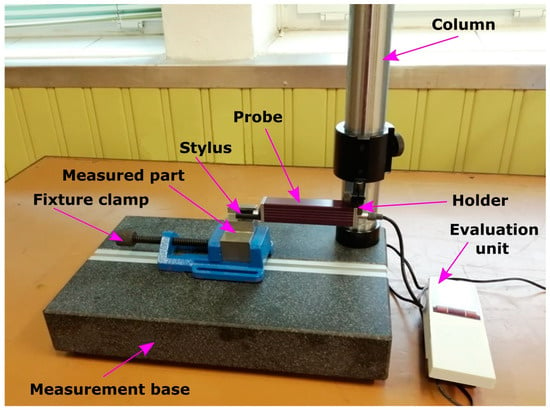
Figure 1.
Stylus-based surface roughness measurement using a surface tester.
A touch profilometer is a contact profilometer that brings the stylus tip into direct contact with the measuring surface and tracks or moves along a desired path to determine the topography of the surface. The working principle of a touch profilometer is to analyze the topography of a surface using a probe that physically moves over the surface to obtain surface properties such as height.
An unspecified (due to commercial reasons) stylus-based surface roughness tester was used for experimental measurements. The device allows you to set four different values of the cut-off filter parameter (0.08 mm; 0.25 mm; 0.8 mm; 2.5 mm). However, the manufacturer of the surface tester does not define the maximum permissible error or measurement uncertainty, so it is necessary to determine this uncertainty in some way for measurement purposes.
The surface tester used has a manufacturer-defined resolution for the Z-axis, i.e., for measuring height characteristics with a value of 0.02 µm. This data applies to the largest measurement range that this device has available. Since the device has an automatic selection of the measurement range, for reporting measurement uncertainty, we will consider this resolution value as a potential source of measurement uncertainty.
The resolution is not defined for the X-axis, but this data can be determined from the sampling that the device performs at individual settings (Table 1). For individual setting values of the cut-off filter parameter, the sampling for the X-axis also changes.

Table 1.
Surface tester sampling and resolution at different settings.
This device for evaluating individual quantities uses the course of the surface roughness profile curve with resolution values for individual measurement axes (X-axis in the horizontal plane and Z-axis in the vertical plane). These are longitudinal measurements, from which the values of individual surface roughness values are then indirectly determined by calculation in accordance with the relevant standards. Thus, determining the measurement uncertainty for Ra, for example, is a rather complicated task beyond the scope of this article. In this article, we will attempt at least an approximate estimation of the measurement uncertainty because, in our opinion, each measurement must have an associated measurement uncertainty in order to be able to evaluate the reliability of the mentioned experimental measurements [41,42,43,44,45,46,47,48,49].
Therefore, if we consider the differences in measurement in both directions as a significant source of uncertainty, then we can state them as the standard uncertainty determined by method B:
uBX = 1.5 µm
uBZ = 0.02 µm.
uBZ = 0.02 µm.
If we consider that the digital device and the measured quantities follow the uniform distribution law of random values, then we will consider the extended measurement uncertainty with a coverage coefficient with a value of √3 at the significance level of 0.95. Then we will consider the expanded uncertainties of the displacement measurement:
It should be emphasized that this is only a very rough estimate, and for a more precise determination of the measurement uncertainty, it is also necessary to consider the uncertainty resulting from the geometry of the measuring tip, the uncertainty resulting from its elastic deformation during measurement, the uncertainty resulting from lateral movements during measurement, the uncertainty resulting from the noise of the device. It is very complicated to identify all components of measurement uncertainty when using such a complex device.
The surface tester used has the function of automatic calibration using secondary surface roughness standards. Secondary surface roughness standards for surface roughness testers, which is a calibration etalon artifact with unidirectional irregular profile of type D1 (according to ISO 5436-1:2000) [36], is recommended for the calibration of the gauge. For this artifact, the value of Ra and Rz is defined. In this work, this function was used, and the calibration process was started before each batch of measurements; after the calibrations, a control measurement was always carried out to verify the calibration process. Likewise, at the end of the measuring dose, a control measurement was carried out to verify the stability of the surface tester calibration. Secondary surface roughness standards for surface roughness testers (Figure 2) were verified by a superior standard in a certified laboratory, and the uncertainty of this used calibration specimen was determined.
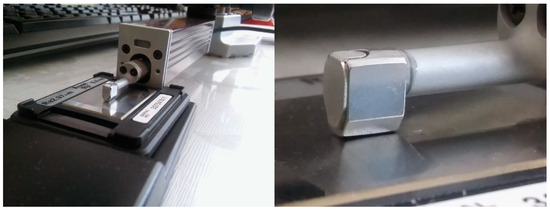
Figure 2.
Surface tester calibration using secondary surface roughness standards.
One way to determine the measurement uncertainty is to look at the gauge as a black box and determine the measurement uncertainty from the statistical evaluation of the data measured on the secondary surface roughness standards. For this purpose, 100 measurements were carried out at the same place under unchanged measurement conditions on the secondary surface roughness standard (measured to the standard—ISO 1997 [33]; 0.25 mm/s; Lc = 2.5 mm; X = 5; Gauss). From the measured values, histograms of the frequency of individual intervals of arithmetic mean height of the roughness and standard deviations of the measurement were created.
The measurement graph (Figure 3) shows the variability and range of measured values of the quantity—Ra for measurement under the same conditions. From these data, it is possible to create a histogram of the frequency of individually measured data (Figure 4), from which the nature of the distribution of the measured data is visible, so in further considerations, we will assume a uniform law of distribution of the measured data.
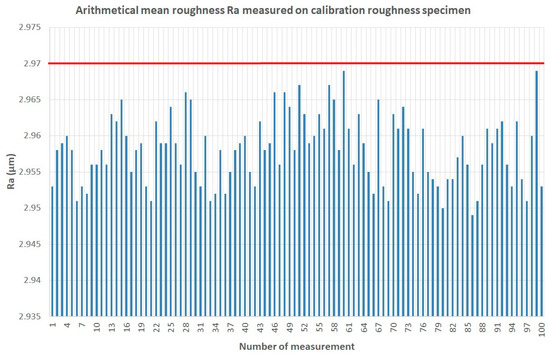
Figure 3.
Arithmetical mean height of the roughness Ra values for 100 measurements at the same place under unchanged conditions (measured on Standard—ISO 1997 [33]; 0.25 mm/s; Lc = 0.8; X = 5; Gauss).
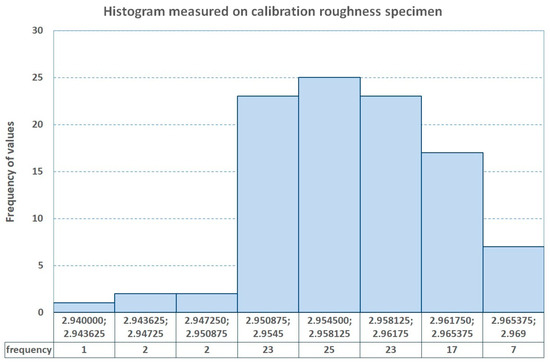
Figure 4.
Histogram for values of arithmetic mean height of the roughness Ra for 100 measurements at the same place under unchanged conditions.
To assess the number of measurements as an indicator, it will be appropriate to use the standard deviation of a series of measurements. The value of these measurements depends on the dispersion of the evaluated values around the mean value. So, the smaller the standard deviation, the smaller the dispersion of the data. The evaluation of the standard deviation is therefore carried out in such a way that the standard deviation of a series of measurements is gradually determined, which is recalculated after the addition of each additional measurement. Therefore, we designated it as the cumulative standard deviation (Figure 5). At the moment when the cumulative standard deviation stops changing, it means that the number of evaluated values has been reached, which will no longer improve the uncertainty of the measurement result. At the same time, these standard deviations give us the answer to the course of the standard deviation with the increasing number of measurements, and thus it is possible to obtain the maximum standard deviation of a series of measurements (Figure 5).
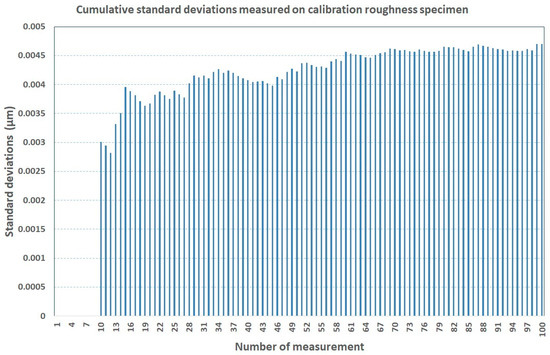
Figure 5.
Cumulative standard deviations for 100 measurements at the same place under unchanged conditions (measured to standard—ISO 1997 [33]; 0.25 mm/s; Lc = 2.5 mm; X = 5; Gauss).
From the stated values of standard deviations, it is possible to consider the maximum value Zmax = 0.005 µm for the standard uncertainty of measurement and evaluation of the quantity Ra for this device. However, the Secondary Surface Roughness Standard itself also contributes to this uncertainty. However, this uncertainty is still very small. This means that the device itself will not show a large measurement uncertainty, and the dispersion of the measured data will instead be related to the dispersion of values as a result of the implemented technology for the surface treatment of the component.
3. Experiments
Quantities of surface roughness are precisely defined in the standard, but obtaining the correct value of these quantities by measurement depends on the correct choice of measurement parameters. These include cut-off filter settings, evaluation standards, number of section lengths, and measuring speed.
Important factors to consider when assessing surface roughness using a stylus-based surface roughness tester:
- -
- The size of the measured irregularities must be appropriate to the measuring range of the sensor (vertical stroke); irregularities exceeding its size of the maximum value of vertical lift cannot be measured.
- -
- The set value of the sensed length should include 5—a multiple of the section length plus the start-up and run-down path of the sensor; if it is not possible to meet this requirement (e.g., due to the size of the measured area), it is necessary to take into account that the result of the measurements will be affected by the failure to meet the requirement.
- -
- The object to be measured must be clamped, orientated spatially, and the sensor must be placed appropriately on the measured surface; for this, it is necessary to choose the appropriate shape of the sensor with regard to its diameter, length, the possibility of fitting the bottom of the groove, the possibility of measuring on roundness, etc.; in case of inadmissibility of the place of measuring the surface roughness of the profilometer sensor, replicas (imprints) of irregularities can be used in plastic film (or other suitable material) and the profile of the irregularities can be taken from this film (negative of the irregularities).
- -
- Corresponding working conditions must be set, including measuring range, sensed length, filter type, basic length (cut-off) of the filter, and speed of the probe.
The measurement conditions during the measurements were as follows:
The surface tester was equipped with a stylus with a sliding tip. The tip of the stylus rides in a line across the surface, moving vertically over the peaks and valleys of the evaluated surface. Changes in the stylus’ height are registered electrically and tracked against the position as the stylus moves, creating a measured profile. The shape of the stylus is conical with a spherical tip with a radius of 2 μm and a tip angle of 60°, and it is pressed with a measuring force of 0.75 mN. The skid force is less than 400 mN. The cone angle and tip radius determine the smallest features that a stylus can trace.
The relative humidity was in the interval (65 ± 5)%, and the temperature was (20 ± 2) °C.
The measurement methodology encounters several problems that need to be defined—here, it must be remembered that even the setting of the measurement conditions can have an impact on the result of the evaluation of the arithmetical mean deviation of the assessed roughness profile. It is, therefore, necessary to give an answer to the question of what this effect is and how to choose individual measurement conditions when assessing surface roughness.
The following measurement conditions are investigated:
- -
- Choice of cut-off filter λc (or textual equivalent Lc): 0.08 mm; 0.25 mm; 0.8 mm; 2.5 mm; 8 mm (the surface tester, which is available for experiments, does not have the setting of the value Lc = 8 mm).
- -
- Choice of standard for evaluation: ISO 1997 [33,34,35,36,37,38,39,40], JIS 1982 [50], JIS 1994 [51], JIS 2001 [52,53,54,55,56,57,58], ANSI Gauss [59,60,61,62], ANSI PC 75 [59,60,61,62], VDA, [63,64,65].
- -
- Selection of speed of the sensing tip (stylus): 0.25 mm/s; 0.5 mm/s; 0.75 mm/s.
3.1. The Influence of the Choice of Standard and the Measuring Speed of the Surface Tester’s Sensing Tip on the Evaluation of the Arithmetic Mean Height of the Roughness Ra
In this part, the influence of the selection of the measurement speed of the sensor tip displacement and the influence of the selection of the standard for the evaluation of the surface roughness values are assessed. Experimental measurements were carried out on the surface roughness standard (Figure 6 and Figure 7) for grinding with nominal values of Ra = 1.6 µm and 3.2 µm. For each combination of the selected speed of the sensor and the evaluation standard, ten measurements were carried out at the same place in order to exclude the variability of the standard sample.

Figure 6.
The influence of the selection of the evaluation standard [33,34,35,36,37,38,39,40,51,52,53,54,55,56,57,58,59,60,61,62,63,64,65] and the selection of the sensor movement speed for 1.6 µm and 3.2 µm samples in spatial imaging (conditions: Lc = 0.25 mm; N = 5).

Figure 7.
The influence of the selection of the evaluation standard [33,34,35,36,37,38,39,40,51,52,53,54,55,56,57,58,59,60,61,62,63,64,65] and the selection of the sensor movement speed for the 1.6 µm and 3.2 µm samples in the column plotting graph for comparison (conditions: Lc = 0.25 mm; N = 5).
The influence of the selection of the evaluation standard and the selection of the sensor movement speed has an effect on the resulting Ra value. It can be concluded that for some standards, this influence is negligible, but for some standards, it is visible that increasing the speed of the sensor movement tends to reduce the resulting Ra value, and this influence is visible mainly for samples with a larger Ra value. It seems like a good choice to use the speed of movement of the sensor with a value of 0.5 mm/s, and the standard of evaluation can be selected according to the country where the evaluation is carried out. For our conditions, we will prefer evaluation according to the ISO 1997 [33,34,35,36,37,38,39,40] standard in further experiments.
The variability of the measured and evaluated Ra data obtained under the same conditions is also an interesting indicator for assessing the influence of the selection of the evaluation standard and the selection of the speed of the sensor movement.
The variability of the data, depending on the selection of the evaluation standard and the speed of the sensor movement, is expressed in percentage terms with respect to the average evaluated values of Ra and is shown in the following figure. The evaluation shows that the variability of the Ra data is in percentage terms up to a maximum of 18% (Figure 8).

Figure 8.
Percentage expression of the variability of the evaluated data Ra if the measurements were carried out for the given standard [33,34,35,36,37,38,39,40,51,52,53,54,55,56,57,58,59,60,61,62,63,64,65] at all possible speeds of the sensor movement.
Evaluations according to JIS1982 [50,51] and JIS2001 [52,53,54,55,56,57,58] standards have the greatest variability of Ra, and evaluations according to ANSI and VDA standards have the smallest variability. The ISO 1997 [33] and JIS1994 [51] standards are somewhere in the middle of these percentage expressions of variability. From these experiments, it can be concluded that the evaluations according to the JIS1982 [50] and JIS2001 [52,53,54,55,56,57,58] standards had the greatest sensitivity to the change in the movement speed of the sensor. However, this result may also depend on the specific sample on which the experiments were carried out (Figure 9).
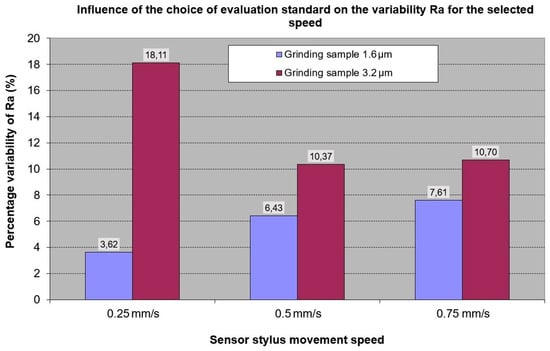
Figure 9.
Percentage expression of the variability of the evaluated data Ra, if the measurements were carried out for specific sensor movement speeds and only the evaluation norm, was changed during the experiments.
In measurements where the speed of the sensor’s movement did not change, and the standard of evaluation was changed, it can be seen that at a speed of 0.25 mm/s, the evaluations of Ra are most sensitive to the choice of the standard according to which the evaluation took place. For speeds of 0.5 mm/s and 0.75 mm/s, this effect was smaller.
Based on the above results, we decided to use a speed setting of 0.5 mm/s in further experiments, and we will use ISO 1997 [33,34,35,36,37,38,39,40] as the evaluation standard.
3.2. The Influence of the Cut-Off Setting on the Evaluation of the Arithmetic Mean Height of the Roughness Ra
According to the cut-off value λc (or the text equivalent Lc), the recommendation is also for the choice of the second parameter cut-off λs (or the text equivalent Ls) according to Table 2 [ISO 11562; ISO 3274] [35,40]. Both values must be set before measuring the assessed surface of the component. This applies except for the VDA [63,64,65], JIS1982 [50], and JIS1994 [51] standards, where this parameter is not used.

Table 2.
Setting the cut-off parameter λs (ISO 3274, ISO 11562); [35,40]. ISO standards are used to report the nominal values of roughness standards.
When choosing the parameters of the cut-off filter, the parameters of the stylus tip must also be taken into account. The recommended combinations of λc, λs, and stylus tip radius are shown in ISO 3274:1996 [35]. The used roughness gauge has a stylus tip that has a radius of 2 μm and an angle of 60° and is pressed with a measuring force of 0.75 mN (Table 3). Some types of surface testers allow you to select only the Lc parameter, and the second parameter of the cut-off filter is automatically set. However, there are also surface testers that allow you to independently set both parameters of the cut-off filter, so the mentioned standards provide a recommendation in the form of a table (Table 3) for choosing these settings. In some cases, the surface tester also allows the replacement of the stylus and thereby changing its geometry, where the standards bring certain recommendations.

Table 3.
Recommended relationship between the cut-off parameters λc, λs according to the used sensing probe ISO 3274, ISO 11562; [35,40].
Similarly, the newer standard ISO 21920-3 [47] introduces default settings for functional parameters (Rk, Rpk, Rvk, etc.) and R- and W- parameters without defined defaults (Table 4). The so-called setting class, while the difference is only in the values of the parameter λs.

Table 4.
Setting classes—recommended settings (ISO 21920-3) [39].
The problem is that if we determine the Ra of the assessed surface, we choose L-filter Lc. If, for example, we choose a too-small value of L-filter Lc for the sample, then the result is Ra with an almost zero size. However, if we choose a value of Lc that is too large, then the value of Ra may also include the effect of waviness and will distort the value of Ra. The mistakes we make when choosing a bad cut-off can be huge and can have a fatal impact on the result of evaluating the roughness of the surface of the component under consideration. We will try to solve this problem in this work.
For the practical measurement of surface roughness parameter values, it is important to choose the L-filter Lc (the cut-off value for the stylus-based surface roughness tester) in such a way that it includes a sufficient number of profile irregularities characterizing its roughness and at the same time excludes the influence of irregularities with a larger spacing (with longer wavelength) of inappropriate roughness (profile waviness and profile shape). For the comparability of the surface roughness measurement results, the values of the basic length Lc (cut-off) are determined by the standard. The nominal values of the limit lengths of the profile filter Lc (cut-off) are selected from the following series: 0.08 mm, 0.25 mm, 0.8 mm, 2.5 mm, and 8 mm. To obtain sufficiently accurate values of the surface roughness parameters, it is recommended to choose the evaluated length as several times the basic length (usually five times) (Table 4).
For sensor feed speed rates, the manufacturer’s recommendation is to use selected values of the measuring feed speed. The assessment of the influence of Lc on Ra values will therefore be carried out at a feed speed of 0.5 mm/s because this speed is recommended for all Lc values, and at the same time, the results of our experiments in the previous chapter confirm the correctness of this choice (Table 5).

Table 5.
Recommended measuring speed values for Lc (ISO 11562; ISO 3274) [35,40].
According to the standards for evaluating the surface roughness, the cut-off parameter λc (also referred to as Lc) determines the basic length of the evaluated profile lm. The standard STN EN ISO 4288 [34] provides recommended values (see Table 6) for the choice of cut-off Lc and section and evaluation of lengths according to the values of the roughness parameters of periodic and non-periodic profiles. In the ISO 21920-3 [39] standard, the Setting class parameters (Table 4) are similarly designed but already uniformly for all types of surfaces and without justification. In our opinion, it is also necessary to take into account the technology used to evaluate the surface of the component. The origin and conditions of the mentioned recommendations are not clear, and therefore, in the next part of this work, experiments will be carried out on samples produced by different technologies to verify these recommendations.

Table 6.
Roughness length section for measurement and curves and corresponding parameters for non-periodic profiles (EN ISO 4288, ISO 21920-3) [34,39].
In the next part, we will distinguish the so-called periodic and non-periodic surface roughness profiles (See Appendix A).
The ISO 21920-3 [39] standard introduces no distinction between periodic and non-periodic profiles compared to the edition of ISO 4288:1996 [34]. Nevertheless, the following part is focused on the analysis in the course of the choice of cut-off filter for individual technologies, which were used to produce individual samples.
3.2.1. Effect of Cut-Off Filter Setting for Non-Periodic Surface Roughness Profiles
The goal is to identify the effect of setting the cut-off filter Lc on Ra values for individual types of reference samples processed by different technologies.
The standard (EN ISO 4288 and ISO 21920-3) [34,39] recommends setting the cut-off parameter Lc or section length lsc and evaluation length lm according to the Ra value. Evaluation length is recommended as five times the section length lsc.
Here the aforementioned problem arises concerning how to set the L-filter or section length and evaluation length according to an unknown Ra value. This problem does not make sense and creates a challenge with the measurement procedure defined in this way because it is the choice of the basic length that has a significant impact on the result of the Ra evaluation process. This paradoxical recommendation can significantly influence the result of the surface roughness evaluation.
Some standards for the evaluation of surface roughness quantities differ in these recommendations, stating different values of the parameter Lc for the values of Ra. These differences are shown in the following Figure 10. The JIS B0601-1982 [50] standard, for example, recommends using a cut-off filter with a value of Lc = 0.8 mm for values of Ra < 12.5 µm. For all larger Ra values, it is recommended to use Lc = 2.5 mm. Other standards for evaluation use more finely graded cut-off filters, which complicate the situation when setting the cut-off Lc filter during measurement.
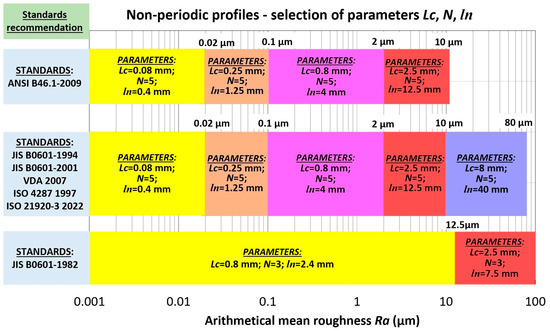
Figure 10.
Recommendations of the standards [33,34,35,36,37,38,39,40,50,51,52,53,54,55,56,57,58,59,60,61,62,63,64,65] for the selection of the cut-off Lc parameter for non-periodic profiles.
For the experimental investigation, selected samples of non-periodic surface roughness profiles with different Ra values were processed using the technology (Figure 11), (Table 7):
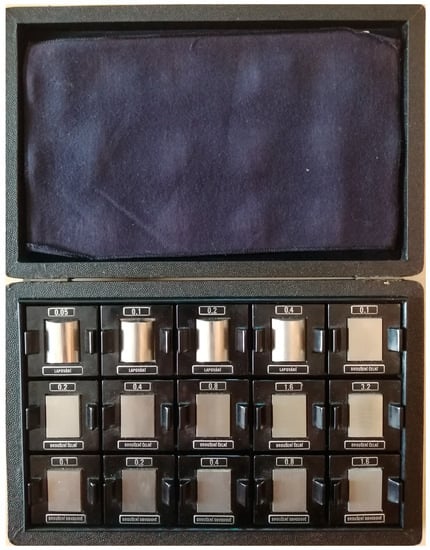
Figure 11.
Etalon samples of surface roughness—Lapping and grinding operation.

Table 7.
Selected evaluated non-periodic profile samples.
- -
- Lapping operation samples.
- -
- Peripheral grinding operation samples.
- -
- Face grinding operation samples.
Measurements were carried out for each setting of the cut-off filter Lc and for each sample at ten randomly selected locations in the central region of this sample. The average values were shown in graphs (Appendix B), also showing the value of Ra for each reference sample.
To assess suitability, it is necessary to observe the deviation of the average value from the Ra value of the reference sample. We were looking for a setting of the cut-off filter Lc for which the average value has the smallest deviation with respect to the reference nominal value Ra.
For experimentally assessed non-periodic surface roughness profiles (lapping, peripheral grinding, and face grinding), the optimal setting of the cut-off filter Lc was observed for some reference samples, which is recommended in the ISO standard [33,34,35,36,37,38,39,40]. However, for some samples, other recommended settings of the cut-off filter Lc (for samples with larger Ra values) were obtained.
For the mentioned non-periodic samples with values up to Ra = 0.1 µm, it is appropriate to use Lc = 0.25 mm. Then, for values from Ra = 0.1 µm to Ra = 0.4 µm, it is appropriate to use Lc = 0.8 mm. From a value of Ra = 0.4 µm, it is advisable to use Lc = 2.5 mm. It is shown more vividly in the following Figure 12, while for comparison, the recommended settings of the cut-off Lc filter according to the ISO standard [33,34,35,36,37,38,39,40] are also shown.
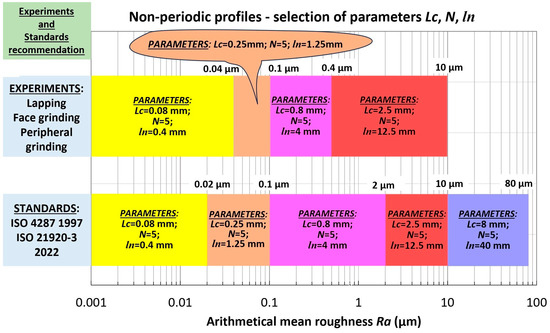
Figure 12.
Optimal setting of the cut-off filter Lc for tested reference samples of non-periodic profiles and setting recommended by standards [33,34,35,36,37,38,39,40,50,51,52,53,54,55,56,57,58,59,60,61,62,63,64,65].
The shift of the boundary between Lc = 0.8 mm and Lc = 2.5 mm may be due to measurement uncertainties. The area with the cut-off value of the filter Lc = 0.25 mm starts only at the value Ra = 0.04 µm because reference samples with a smaller value of Ra were not available for the experiments.
On the basis of the above, it can be concluded that the guidelines according to the standard for the settings of the cut-off filter Lc are applicable for obtaining relevant results for the evaluation of the surface roughness quantity Ra (Figure 12).
3.2.2. Effect of Cut-Off Filter Setting for Periodic Surface Roughness Profiles
For the experimental investigation, standard samples of periodic surface roughness profiles (Figure 13) with different Ra values were selected and processed using the technology (Table 8):

Figure 13.
Etalon samples of surface roughness—milling operation, turning operation, and planing operation.

Table 8.
Selected evaluated periodic profile samples.
- -
- Milling operation with a slab mill cutter
- -
- Milling operation with a face mill cutter
- -
- Turning operation
- -
- Planing operation
For periodic profiles (turning, milling, planing), the ISO 4288:1996 standard [34] recommends monitoring the mean spacing of the profile elements RSm (Appendix A) (ISO 21920-2) [38] as a parameter for choosing the cut-off filter Lc. Here again, the problem arises in that the setting of the cut-off filter Lc is dependent on the value of the parameter, in this case, RSm, which, however, will only be available as a result of the evaluation of the surface roughness measurement. Standard ISO 4288:1996 presents a table of recommended values of section length or filter cut-off according to RSm values (Table 9).

Table 9.
Recommended cut-off values of the Lc parameter or section lengths lr and evaluated lengths ln for periodic profiles according to ISO 4288:1996 [34].
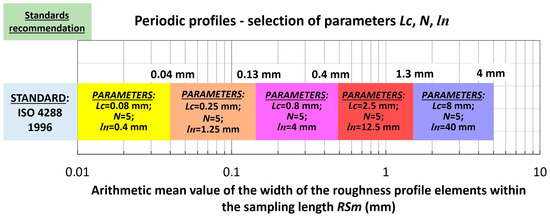
Figure 14.
Recommendation for the selection of parameters of the cut-off filter Lc for evaluating the surface roughness of samples according to the ISO 4288:1996 standard.
Table 9.
Recommended cut-off values of the Lc parameter or section lengths lr and evaluated lengths ln for periodic profiles according to ISO 4288:1996 [34].
| Mean Spacing of the Profile Elements RSm (mm) | Roughness Sampling Length lr (mm) | Roughness Evaluation Length ln (mm) |
|---|---|---|
| 0.013 < RSm ≤ 0.04 | 0.08 | 0.4 |
| 0.04 < RSm ≤ 0.13 | 0.25 | 1.25 |
| 0.13 < RSm ≤ 0.4 | 0.8 | 4 |
| 0.4 < RSm ≤ 1.3 | 2.5 | 12.5 |
| 1.3 < RSm ≤ 4 | 8 | 40 |
Note: in the experimental measurements in this work, where the RSm value is not given, it means that it could not be evaluated because there were not enough peaks and valleys on the measured surface profile. This condition occurs if the selected cut-off parameter is inappropriate, for example, the cut-off value is too small) or it does not allow the shape of the surface profile of the evaluated surface of the sample, or Ra has a large value, and the device does not provide a sufficient cut-off value. The recommendation for the selection of the cut-off filter is also summarized graphically in the following Figure 14. In this part of the article, an attempt is made to verify these recommendations for different types of machining samples. For experimental testing, selected samples were machined by turning, planing, milling with a cylindrical milling cutter, and milling with a face milling cutter. The parameters Ra and RSm were observed.
The results for individual technologies for periodic profiles (Appendix C) were subjected to the above analyses, and the optimal setting of the cut-off filter Lc for each technology was determined. Figure 15 shows a comparison of the selection of the filter cut-off value Lc for periodic profiles with the recommendations for the selection of the filter cut-off value Lc according to ISO 4288/1996 [34].
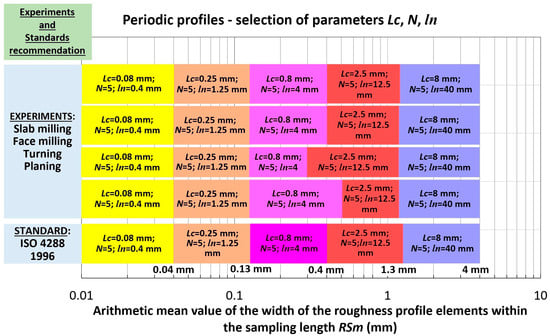
Figure 15.
Obtained recommendations for the choice of cut-off filter Lc and recommended according to ISO 4288/1996.
Samples produced by both methods of milling (Figure 15) are in accordance with the recommendations of the mentioned ISO standard. For the turned and planed samples, slight disproportions are visible in the intervals suitable for the free cut-off values of the Lc filter; however, these interval shifts may be related to measurement uncertainties.
The analysis of surface roughness profiles, RSm values, and Ra values reveals the interesting fact that for all samples of periodic roughness surfaces, it is advisable to proceed in such a way that to determine the parameter RSm, it is advisable to carry out measurements at all settings of the cut-off filter Lc (similarly to what was carried out in the case of individual technologies of periodic profiles) and according to the detected surface roughness profiles, it is then possible to determine the value of RSm. When evaluating RSm, the character of the course of the surface roughness profile must be observed and whether there are signs of periodicity typical for the given type of machining, and whether the influence of the waviness of the surface profile is no longer visible. For the RSm value determined in this way, it is then possible to select the cut-off filter parameter Lc for further repeated measurements according to the recommendations in the ISO 4288/1996 standard [42], and with this procedure, it is then possible to obtain the correct value of Ra.
In order to verify the correct determination of the Ra value, it is also possible to perform comparative measurements using the Comparex comparative microscope, similar to what was done with non-periodic samples. In this way, it is possible to confirm the correct selection of the cut-off filter value Lc.
3.2.3. No Discrimination Periodic and Non-Periodic Profiles for Procedure of Ra Estimation
It was complicated for users working with unknown surfaces to identify whether it was a periodic profile or a non-periodic one. In some cases, even with the same evaluated surface, it could happen that a profile that was periodically changed to a non-periodic one. This made the strategy of measuring and evaluating surface roughness quantities difficult. Subjective assessment of component surfaces can thus cause errors caused by the operator himself. ISO 21920-1, ISO 21920-2, and ISO 21920-3 standards [37,38,39] eliminate these problems. The ISO 21920-3 standard specifies the non-discrimination procedure for periodic and non-periodic profiles for the roughness quantities estimation procedure. This edition of ISO 21920 cancels and replaces the edition of ISO 4287:1997 [33] and ISO 4288:1996 [40], which have been technically revised. ISO 21920-3 introduces no distinction between periodic and non-periodic profiles. The ISO 21920-3 standard introduces a unified strategy for setting measurement parameters using setting classes—Sc1, Sc2, Sc3, Sc4, and Sc5.
In cases of missing part surface specifications, one of the options for determining the surface roughness of the examined part is to compare the surface roughness profile with the surface roughness profile of the standard sample whose nominal Ra value is known. For this purpose, the Comparex monocular comparison microscope (Figure 16) can be used.
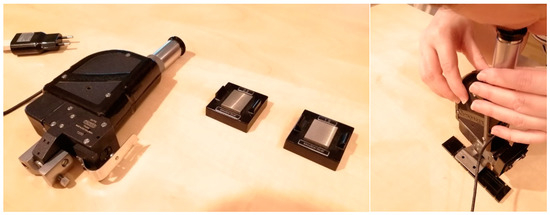
Figure 16.
Comparex comparison microscope for determining surface roughness.
It is a device that enables the determination of surface roughness on different types of surfaces obtained by all available technologies. The eyepiece is divided into two halves, and both surfaces of the surface roughness are displayed in it, namely the surface of the part and the surface of the reference sample, so it is possible to optically compare both surface profiles. According to these displayed profiles, it is possible to make a fairly reliable estimate of the Ra of the examined sample.
By successively optically comparing the surfaces of the reference samples with the examined surface of the component, it is possible to determine the desired value of Ra for the surface of the component (Figure 17). In Figure 17 is a comparison with the standard sample Ra = 1.6 µm, and from the image of the eyepiece, it can be seen that the standard has a greater surface fragmentation than the examined surface of the part. Then the surface of the component is compared with the reference sample Ra = 0.8 µm, and a match is visible (Figure 18), based on which we can estimate the value of Ra and then subsequently set the cut-off parameter Lc for the subsequent measurement and evaluation of Ra using stylus-based surface roughness tester.

Figure 17.
Comparison of the surface roughness profile of the part and the reference sample with a nominal value of Ra = 1.6 µm.

Figure 18.
Comparison of the surface roughness profile of the part and the reference sample with a nominal value of Ra = 0.8 µm.
The ISO 21920-3 standard [39] also provides recommendations for the selection of Setting class settings according to the estimate of the unknown quantity of surface roughness Ra (Table 10). The graph (Figure 19) shows a comparison of the recommendations of both ISO 4287 [33] and ISO 21920-3 [39] standards and the results of experiments for non-periodic part surface profiles. It results in only slight differences, which can be considered measurement errors and uncertainties.

Table 10.
Setting classes—recommended settings for cases of missing specification (ISO 21920-3) [39].
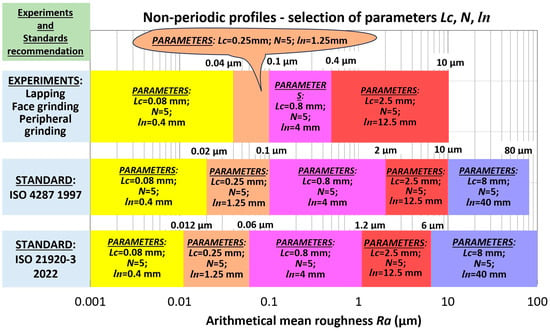
Figure 19.
Optimal setting of the cut-off filter Lc for tested reference samples of non-periodic profiles and recommended settings according to ISO 4287 and ISO 21920-3 standards.
For periodic profiles, preferred values resulting from experiments and recommended values according to the ISO 4288 standard and according to the ISO 21920-3 standard are shown. Except for planing technology, all values for periodic profiles are in accordance with the recommendations of the ISO 21920-3 standard. Planing technology does not agree with these recommendations, and the reasons for this are probably found in the essence of the technology itself. It is important to note that reference samples were not available for ranges with small Ra values, which is related to the nature of these technologies, which are used to achieve larger Ra values, and thus it was not possible to assess the recommendations of the standards for smaller Ra values. Interestingly, however, the experimental optimum settings for the periodic profiles are in agreement with the recommendations of the previous ISO 4288 standard.
With the exception of planing technology, however, we can state that the recommendations of the ISO 21920-3 standard can be applied to periodic and non-periodic profiles of the surface of components (Figure 20), and therefore the investigation of planing technology will be the subject of further research.
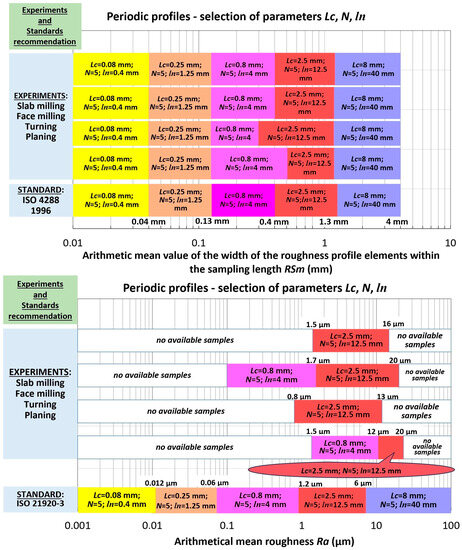
Figure 20.
Comparison of optimal cut-off filter settings for individual technologies for tested samples of periodic profiles and recommended settings according to ISO 4287 and ISO 21920-3 standards.
A comparison of the validity of using RSm to select the cut-off filter Lc according to ISO 4288 and using Ra according to ISO 21920 can be realized from the evaluation of the previous graphs (Figure 20). According to this evaluation, it can be concluded that better compliance results were achieved using the RSm quantity according to ISO 4288. At the same time, however, it can be seen that there were not enough samples available for a reliable evaluation, mainly with low Ra values, which follows from the nature of these technologies, as they are designed to achieve surfaces with larger Ra values. We will further verify these results in future research.
3.3. Identification of the Minimum Number of Measurements for Assessing the Surface Roughness of the Part
To define the problem, it is necessary to determine the minimum number of measurements needed to assess the surface roughness. It is known from common metrological practice that one measurement is insufficient and, especially for quantities with a high degree of variability, it is necessary to carry out repeated measurements and an estimate of the measured quantity together with an expression of the uncertainty of the determination of this estimate of the measured quantity.
To solve this problem, a method of successive evaluation of the standard deviation of repeated measurements and evaluation of the quantity Ra is proposed. After each additional measurement is added, the standard deviation will be recalculated with the addition of a new value to the set of measured data. We called it the cumulative standard deviation, which will capture the effect of the number of performed measurements on the value of the standard deviation of the quantity Ra.
First, 100 measurements were carried out at different measurement points on selected reference samples from each technology for which samples were available while the Ra quantity was evaluated. Thus, the influence of the variability of the sample implementation on the resulting variability of the measured data will be clear. Figure 21 shows the cumulative standard deviations for non-periodic profiles, and it follows that the first values of the cumulative standard deviations are unstable, which indicates a high degree of variability of the evaluated Ra data. Thus, it is clear that the number of measurements is insufficient. Only after 30 measurements is the cumulative standard deviation stabilized, and therefore, it is the optimal number for determining a reliable value of the surface roughness when measuring at different places of the examined surface of the component. Similarly, for samples with periodic profiles, the cumulative standard deviations are evaluated (Figure 22). It also follows from them that the optimal number of measurements for determining a reliable value of the quantity Ra is 30. Further increasing the number of measurements does not significantly improve the cumulative standard deviation of the measurement.
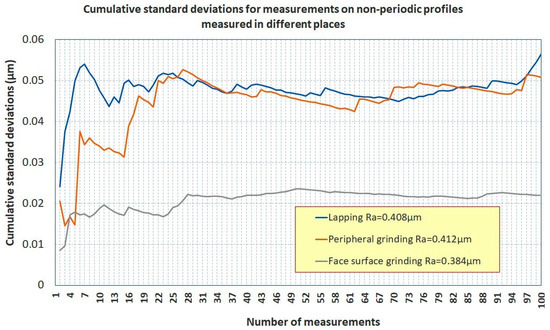
Figure 21.
Cumulative standard deviations for the evaluation of the quantity Ra when measured at different locations of samples with a non-periodic surface profile.
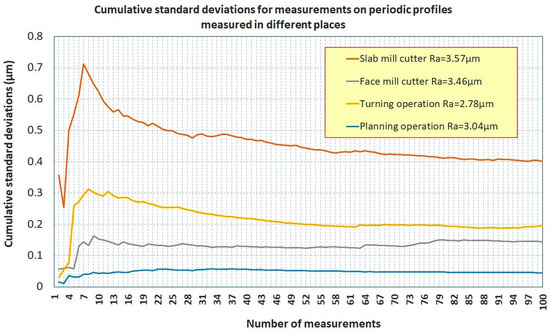
Figure 22.
Cumulative standard deviations for the evaluation of the quantity Ra when measured at different locations of samples with a periodic surface profile.
In the next step, repeated measurements and evaluations of Ra were again carried out for the same reference samples from each technology that was used for deposition. However, the measurements were carried out 30 times at the same place under the same measurement conditions. These measurements and evaluations should provide information on the variability of Ra values, excluding the influence of the technology itself on the uniformity of the surface roughness of the examined sample.
In Figure 23, cumulative standard deviations for non-periodic profiles are evaluated. In the first values, instability is visible, which indicates a high variability of the Ra values, but after 15 measurements, the value of the cumulative standard deviation stabilizes, which indicates that the number of measurements of 15 is sufficient for all technologies and further measurements will no longer bring a rapid improvement in the variability and uncertainty of the value of the quantity Ra.
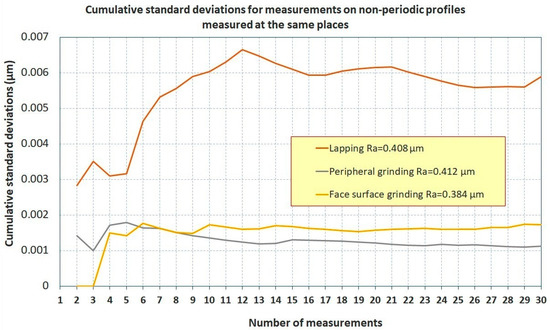
Figure 23.
Cumulative standard deviations for the evaluation of the quantity Ra when measured at the same place on the surface of samples with a non-periodic surface profile.
In Figure 24, cumulative standard deviations for periodic profiles are similarly evaluated. Additionally, in this case, with these technologies, 15 measurements are sufficient to obtain the value of the quantity Ra.
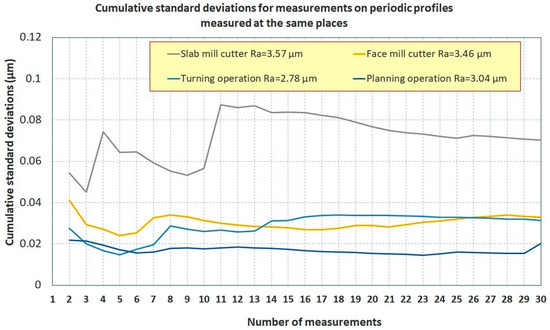
Figure 24.
Cumulative standard deviations for the evaluation of the quantity Ra when measured at the same place on the surface of samples with a periodic surface profile.
4. Discussion
The roughness of the surface is defined by the micro-geometry of the surface of the components, and to define this micro-geometry, a range of quantities are used, which are determined in this contact type of measurement from the identified surface profile. Since these are micro-dimensions, high demands are placed on the resolution and precision of the stylus and evaluation unit of the surface roughness tester.
The surface roughness and its quantities are characterized by a high degree of variability, and this is also related to the fact that it is quite difficult to implement the individual surfaces of the components so that their surface roughness is the same in every place of this surface.
The variability of the measured and evaluated data in this type of measurement is also related to the fact that the measurements are carried out indirectly, i.e., the profile of the surface of the examined surface of the contact method is measured using a stylus, and a very small displacement is seen in the vertical and horizontal direction.
The preparation and setting of the measurement parameters require a lot of attention, and poor implementation will cause incorrect measurement and evaluation results to be obtained. This can introduce additional errors and uncertainties into the measurement process; therefore, it is necessary to solve this problem with research such as that in this article, which can provide guidance on how to correctly implement the measurement process and evaluation of the quantity Ra.
Before carrying out the measurement, it is necessary to check the surface tester using a reference specimen and, if necessary, to carry out the calibration of the meter, and we recommend carrying out this check continuously during a large number of measurements or at least at the end of a set of measurements in order to eliminate measurement errors related to the detuning of the surface tester. The internal structure of the stylus contains fine mechanics and sensor and actuator systems that are extremely sensitive to improper handling and unsuitable environmental conditions; therefore, measurements and calibrations must be approached very carefully and sensitively, as rough handling often results in damage to the surface tester or reference specimen.
Determining the uncertainty for the roughness surface tester is, in this case, a very difficult task that exceeds the scope of this work, but it is possible to make at least an estimate of the measurement uncertainty using the resolution values of the displacement measurement for both axes X, Z. Evaluation of the uncertainty Ra based on data on errors and uncertainties of the sensor and positioning of the stylus system is, therefore, a task that may be addressed in further future research.
In order to determine at least a rough estimate of the uncertainty of the gauge, 100 measurements were made at the same place under unchanged measurement conditions, and the values of the quantity Ra were evaluated. The cumulative standard deviation method was used to monitor the influence of the number of measurements as well as the statistical model of the distribution of the measured data. From these measurements and evaluations, it can be concluded that the used surface tester is in excellent condition, and the maximum standard deviation did not exceed 0.005 µm. The distribution of the measured values did not match the Gaussian normal law of the distribution of random values, so for the further use of the device and the evaluation of the surface roughness values, a uniform law of the distribution of the measured values will be considered.
The actual measurement of the surface structure usually takes only a few seconds and is determined by the feed speed and the scanned length, and other settings, but the measurement preparation time is considerably longer, on which the success of the measurement depends. Before the measurement and evaluation process, it is necessary to set several input parameters for the measurement, which can have a very significant impact on the actual measurement and evaluation of individual surface roughness quantities. The effort was to solve this problem, and thus the influence of individual settings of the surface tester on the process of measurement and evaluation was investigated; however, due to the difficulty of this issue, this article focuses mainly on the quantity Ra, which is evaluated by the used surface tester. The effect of the selection of the evaluation standard, the effect of the speed of the stylus movement, and the effect of the cut-off filter value on the resulting Ra value were monitored for different types of machined parts surfaces, where standard samples with a known Ra value were used.
To investigate the influence of the stylus speed and the choice of standard, experimental measurements were carried out on a standard sample of surface roughness for grinding with nominal values of Ra = 1.6 µm and 3.2 µm, where for each combination of the selected speed of the sensor and the evaluation standard, ten measurements were carried out on it in a certain place to exclude the variability of the standard sample. The influence of the choice of the evaluation standard and the choice of the sensor movement speed can have a significant impact on the resulting Ra value, and it can be concluded that for some standards, this influence is negligible, but for some standards, it can be seen that increasing the sensor movement speed tends to reduce the resulting Ra value and this influence it is mainly visible in samples with a larger Ra value. A good choice seems to be to use a speed of movement of the sensor with a value of 0.5 mm/s, and the evaluation standard can be selected according to the country where the evaluation is carried out. For our conditions, it was preferred in the experiments and then also the evaluation according to the ISO 1997 standard. To assess the impact of the choice of the evaluation standard and the choice of speed of movement of the sensor, the variability of the measured and evaluated Ra data obtained under the same conditions is also an interesting indicator.
The variability of the data, depending on the choice of the evaluation standard and the speed of the sensor movement, is expressed as a percentage with respect to the average evaluated Ra values, and from its evaluation, it follows that the variability of the Ra data is a maximum of 18% in percentage terms.
Another monitored and problematic setting is the setting of the filter cut-off value Lc, and this can be seen from the conducted experiments, where it is clear that if, for example, we choose a too-small Lc value for the sample, then the result is Ra with an almost zero size. However, if we choose a value of Lc that is too large, then the value of Ra may also include the influence of waviness, and this may distort the value of Ra, so the errors that we make with a bad free cut-off may be huge and may have a fatal impact on the result of evaluating the roughness of the surface being assessed parts.
The ISO 3274:1996 [35] standard contains guidelines on how to set the cut-off value of the Lc filter for non-periodic surface roughness profiles, while the EN ISO 4288 [34] standard recommends setting the cut-off parameter Lc or of the basic length lr and the evaluated length ln according to the Ra value, while the evaluated length ln is recommended as five times the basic length lr. Here the problem arises of how to determine the basic length and the evaluated length according to the unknown Ra value, which creates a problem with the measurement procedure defined in this way because the choice of the basic length has a significant impact on the result of the process of evaluating the average arithmetic deviation of the considered profile. This paradoxical recommendation can influence the result of the surface roughness evaluation to a significant extent.
The origin and conditions of the mentioned recommendations of these standards are not clear, and therefore in this article, experiments were carried out on samples produced by different technologies to verify these recommendations. It is, therefore, necessary to take into account the technology used to evaluate the surface of the component, and therefore the goal was to identify the effect of the cut-off filter setting Lc on the Ra values for individual types of reference samples processed by different technologies.
For experimentally assessed non-periodic surface roughness profiles (lapping, peripheral grinding, and face grinding), the optimal setting of the cut-off filter Lc was observed in some reference samples as the one recommended in the ISO standard, but for some samples, other recommended cut-off settings were found off filter Lc (for samples with larger Ra values). However, on the basis of the above results, it can be concluded that the guidelines according to the standard for the settings of the cut-off filter Lc are generally applicable for obtaining relevant results for the evaluation of the surface roughness quantity Ra; however, the company that produces machined parts must verify these settings for its technology in order to achieve reliable results of measurement and evaluation of surface roughness values.
In the article, a methodology was proposed as one of the options for determining the surface roughness of the examined part by comparing the surface roughness profile with the surface roughness profile of the standard sample whose nominal Ra value is known. For this purpose, it is possible to use the Comparex comparative monocular microscope, with which experimental measurements were carried out in the work, and then based on these measurements, it is possible to estimate the value of Ra and then subsequently set the cut-off parameter Lc for the subsequent measurement and evaluation of Ra using Stylus-based surface roughness tester.
For periodic profiles (turning, milling, planing) the ISO 4288:1996 standard [34] recommends monitoring the quantity—the average distance of the profile elements RSm as a parameter for choosing the cut-off filter Lc, and thus the problem arises again in that the cut-off setting of the filter Lc depends on the value of the parameter in this case RSm, which, however, will be available only as a result of the evaluation of the surface roughness measurement. The experimental results of measurements and evaluation of Ra for individual technologies for periodic profiles were subjected to the above analyses, and the optimal setting of the cut-off filter Lc for each technology was determined. For some samples, slight disproportions are visible in the intervals suitable for the free cut-off values of the Lc filter; however, these interval shifts may be related to measurement uncertainties.
The analysis of surface roughness profiles, RSm values, and Ra values shows the interesting fact that for all samples of periodic surface irregularities, it is advisable to proceed in such a way that to determine the parameter RSm, it is advisable to carry out measurements at all settings of the cut-off filter Lc (similarly to what was done in the case of individual technologies of periodic profiles) and according to the detected surface roughness profiles, it is then possible to determine the value of RSm. When evaluating RSm, the character of the course of the surface roughness profile must be monitored and whether there are signs of periodicity typical for the given type of machining, and whether the influence of the waviness of the surface profile is no longer visible.
For the RSm value determined in this way, it is then possible to select the filter cut-off parameter Lc for further repeated measurements according to the recommendations in the ISO 4288/1996 standard. With this procedure, it is then possible to obtain the correct Ra value and, in addition, it is also possible to carry out comparative measurements using the Comparex comparison microscope for the verification of the correct determination of the value of Ra, similar to what was done with non-periodic samples, and thus it is possible to confirm the correct selection of the cut-off filter value Lc.
The existence of newer standards of the ISO 21920-1, ISO 21920-2, and ISO 21920-3 series [37,38,39] brings the methodology of non-discrimination of periodic and non-periodic profiles and unifies the recommended gauge settings for measuring surface roughness quantities. For non-periodic profiles, the recommended settings are slightly shifted to smaller Ra values, and it can be stated that the new methodology, according to the ISO 21920-3 standard [39], is in agreement with the experimental values from the previous standards ISO 4287 [33], ISO 4288 [34]. For periodic profiles, the situation is more complicated, as the previous standard ISO 4288 [34] used the RSm parameter to determine the optimal settings, but by comparing the experimentally determined optimal settings, it was found that, except for planing technology, all values for periodic profiles are in accordance with the recommendations of the ISO 21920-3 standard [39] and therefore the investigation of planning technology will be the subject of further research.
Another problem addressed in this article is how to determine the necessary number of repeated measurements needed to determine the value of the quantity Ra, and to solve this problem, a method of successive evaluation of the standard deviation of repeated measurements and evaluation of the quantity Ra is proposed. After each additional measurement, the standard deviation will be recalculated with the addition of each new value to the set of measured data. That is why this method was called cumulative standard deviation, which will thus capture the impact of the increasing number of performed measurements on the value of the standard deviation of the quantity Ra.
One hundred measurements were carried out at different measurement points on selected reference samples from each technology for which samples were available, while the quantity Ra was evaluated, and from these experiments, it follows that the optimal number of measurements is 30 for all used samples from the available technologies. In the next stage, repeated measurements and evaluations of the quantity Ra were carried out again for the same reference samples, but the measurements took place at the same place of each sample under the same measurement conditions, and from the calculated values of the cumulative standard deviations, it follows that the optimal number of measurements for this case on all samples is 15 measurements.
5. Conclusions
In this work, specific problems related to the process of measurement and evaluation of surface roughness quantities were solved, and samples of non-periodic surface roughness profiles with different Ra values processed using technology were selected for experimental investigation, including lapping operation samples, peripheral grinding operation samples, and face grinding operation samples.
Additionally, samples of periodic surface roughness profiles with different Ra values were processed using the following technologies: milling operation with slab mill cutter, milling operation with face mill cutter, turning operation, and planing operation.
The novelty and contribution of the article is:
(a) Assessment of the condition of the used surface tester by the proposed methodology for determining the variability of the obtained results.
(b) Identification of the influence of individual surface tester parameter settings. A methodology was proposed for assessing the influence of parameters on the resulting value of Ra.
(c) Verification of the standard recommended settings of the cut-off filter for the determination of the quantity Ra and determination of the methodology for the process of measurement and evaluation for periodic and non-periodic profiles.
(d) Experimental determination of the optimal number of repeated measurements and proposal of a methodology for determining these data.
The results of the work confirmed the validity of assessing the condition of the gauge, and the proposed method is a relatively quick method to implement it.
In conclusion, it should be said that the experiments have shown that for individual technologies, it is appropriate to experimentally verify the methodology for the selection of measurement parameters and the evaluation of surface roughness quantities in order to avoid potential errors in the evaluation of surface quality.
It should be said that all experiments were carried out on a specific surface tester, so it is possible that another device may behave differently. Consequently, it is in the interest of each laboratory to know the status of its surface tester in this way. Additionally, it is also necessary to emphasize that this condition must be regularly checked, and, if necessary, a service intervention must be undertaken.
So far, we have not found studies of a similar type, so it was not possible to compare our results to the results of other studies. The scarcity of similar studies is why this research was conducted. The goal was to solve problems that we encountered in common tasks of evaluating surface roughness.
It should be emphasized that these results are tied to specific reference samples and a specific surface tester. Further experiments on other surface testers and other samples will be necessary to generalize these results. For practical use, it is essential that users identify their surface tester and the manufacturing capabilities of their products in terms of process stability and surface roughness variability. Therefore, in this article, we have tried to solve some practical and scientific problems associated with the assessment of surface roughness.
Many research works solve this problem; however, the influence of surface roughness and frictional forces tend to be neglected, and problems are solved without these important factors. Thus, the real situation can differ very dramatically from mathematical models and simulations where contact surfaces without surface roughness and frictionless were considered forces, and this can result in serious problems in real systems. As a result, many authors have focused on identifying surface roughness and planning technologies to achieve it and also take into account the effect on frictional forces. These are mainly applied in the field of mechanical engineering, mechatronics, robotics, production engineering, machining, biomedical engineering, automotive engineering, tribology, microsystems, precision mechanics, etc. [66,67,68,69,70,71,72,73,74,75,76,77,78,79,80,81,82,83,84,85].
In future research, we plan to develop a method for a more precise evaluation of measurement uncertainties for surface roughness quantities because, for practical use, a suitable methodology is needed to effectively determine the measurement uncertainty.
Author Contributions
Conceptualization, K.P. and T.K.; methodology, M.K.; software, M.K.; validation, K.P., T.K. and M.K.; formal analysis, T.K.; investigation, K.P.; resources, M.K.; data curation, T.K.; writing—original draft preparation, T.K.; writing—review and editing, M.K.; visualization, M.K.; supervision, T.K.; project administration, M.K. All authors have read and agreed to the published version of the manuscript.
Funding
This research received no external funding.
Institutional Review Board Statement
Not applicable.
Informed Consent Statement
Not applicable.
Data Availability Statement
Data are unavailable due to privacy or ethical restrictions.
Acknowledgments
The authors would like to thank the Slovak Grant Agency-project VEGA 1/0168/21 and this publication is the result of the project implementation Research and development of intelligent traumatological external fixation systems manufactured by digitalization methods and additive manufacturing technology (Acronym: SMARTfix), ITMS2014+: 313011BWQ1 supported by the Operational Programme Integrated Infrastructure funded by the European Regional Development Fund.
Conflicts of Interest
The authors declare no conflict of interest.
Appendix A
Appendix A.1. Surface Roughness Assessment Methodology According to the Standards and Used Methods of Measurement and Data Processing
Every technology used in the realization of technical surfaces leaves inequalities that are of fundamental importance in the function of these surfaces. It is very difficult to assess the irregularities on the surface, which represent a certain spatial formation. This problem of assessing irregularities (surface structure) is solved by reducing the plane of the section to a plane perpendicular to the surface of the part (Figure A1). The profile of the surface of the component, which is obtained in the plane of the section, is the basic source of information for assessing the structure of the surface of the component.
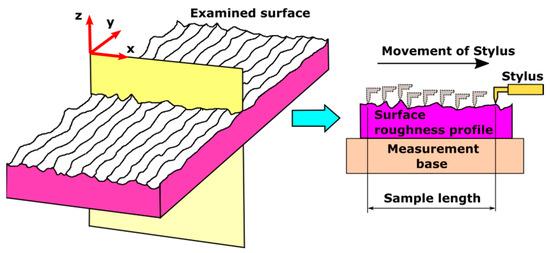
Figure A1.
Part surface profile—as the intersection of the actual surface and the given plane.
Surface texture—geometrical irregularities contained in a scale-limited profile, or the basic surface profile, is divided into two components according to the spacing of the respective irregularities, namely the component with the smallest spacing forming the surface roughness profile and the component with the largest spacing of irregularities determined by the basic profile, namely the waviness profile. The basic profile is the complete profile before the application of the short-wave filter λc (the filter defining the interface between roughness and waviness present on the examined surface). The basic profile represents the basis for the digital processing of the profile using profile filters and for the calculation of profile parameters (Figure A2). Waviness profile—as a profile derived by sequentially applying filters (a filter defining the interface between waviness and longer wave components present on the surface) and profile filters to the base profile (ISO 4287:1997, ISO 4288:1996) [33,34].
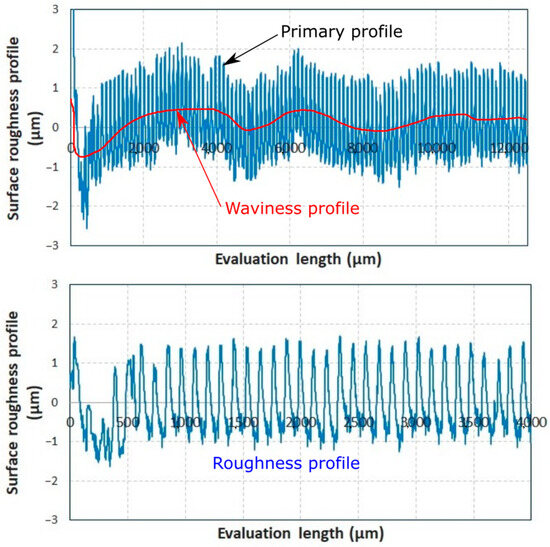
Figure A2.
Profile of waviness and profile of surface roughness.
The cut-off system is created to filter the influence of surface waviness on the process of evaluating surface roughness values (Figure A3). The evaluated profile length ln is divided into several basic lengths (e.g., 5), and these are evaluated separately. The cut-off system is specified by two parameters (Figure 4):
- Cut-off λc (also referred to as Lc in the text), a profile filter that defines the intersection between roughness and even shorter wave components on the surface. We also call it the shortest cut-off.
- Cut-off λs (also referred to as Ls in the text), a profile filter that defines the intersection between roughness and waviness of the profile of the surface under consideration. We also call it the longest cut-off.
Filtering consists of evaluating the wavelengths between these two limits in order to correctly determine the roughness values of the surface under consideration.
Some devices for measuring surface roughness do not allow setting the Ls value for some evaluation standards. This can have an impact on the Ra evaluation results, which was also shown when assessing the impact of evaluation standards on Ra values (see the previous subsection).
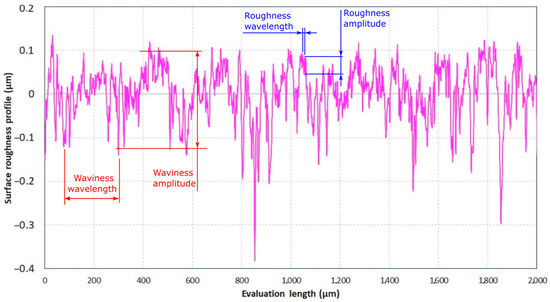
Figure A3.
Amplitudes and wavelengths of the roughness profile and the waviness profile.
For filtering the waviness and shape of the surface of the component, it is necessary to select the values of the profile filters of the wavelength λc, λs, and λf (Figure A4), so that this filtering is possible.

Figure A4.
Wavelengths of surface roughness, waviness, and surface shape of the component.
After applying profile filters for waviness and shape, it is possible to separate the course of surface roughness, course of waviness, and course of surface shape from the obtained surface profile (Figure A5). For standard surface profile measurements, the surface roughness is filtered into two parts, namely the surface roughness profile and the waviness profile, with the shape of the surface of the part.

Figure A5.
After applying a cut-off filter to separate the waviness of the surface profile and the surface roughness of the part.
The newer standard ISO 21920-1 [37] defines these filters with newer designations—profile S-filter type and profile L-filter type for R-parameter or profile S-filter type for W-parameter. The indication of the profile L-filter nesting is a value to specify the large-scale lateral components which are removed for the R-parameter. The indication of the profile S-filter nesting index is a value to specify the small-scale lateral components which are removed for P- and W-parameter (ISO 21920-2) [38]. Profile S-filter is a profile filter that removes small lateral scale components from a profile. Profile L-filter is a profile filter that removes large lateral scale components from a profile.
The setting of measurement parameters is defined in ISO 21920-1 [37] as Symbol ‘Scn’ to specify a setting class number. The symbol Scn indicates what setting class number for the determination of the default settings shall be applied. The setting class number or a default profile L- or S-filter nesting index value shall be specified for the parameter without defined defaults (ISO 21920-3) [39].
Primary surface profile—P: surface profile trace obtained when a surface profile trace is represented as a specified primary mathematical model with a specified nesting index Nis. Primary profile—p profile is scale limited profile at any position x derived from the primary surface profile by removing the form using a profile F-operation with nesting index Nif. The primary profile is the basis for the evaluation of the primary profile parameters.
Waviness profile—W profile is scale limited profile at any position x; derived from the primary profile by removing small-scale lateral components by a profile S-filter with a specified nesting index Nic and with a specified type of filter. The waviness profile is the basis for the evaluation of the waviness profile parameters.
Roughness profile—R profile is scale limited profile at any position x derived from the primary profile by removing large-scale lateral components by a profile L-filter and with the same nesting index Nic and the same type of filter specified for the profile S-filter to obtain the waviness profile. The roughness profile is the basis for the evaluation of the roughness profile parameters.
For the evaluated quantities, the following are then distinguished:
P-prefix parameter—parameter calculated from the primary profile,
W-prefix parameter—parameter calculated from the waviness profile,
R-prefix parameter—parameter calculated from the roughness profile.
Evaluation length lm—The indication of the evaluation length (Figure 6) is a value to specify the length used for identifying the geometric structures characterizing the scale-limited profile (ISO 21920-2) [38]. In the former ISO 4287 [33] profile standard, the evaluation length was given by ln. Evaluation length is length in the direction of the x-axis used for identifying the geometric structures characterizing the scale-limited profile. The evaluated length can contain one or more section lengths. The profile filter is a tool for dividing the profile into long-wave and short-wave components. The filtration process is carried out in several stages, providing modified profiles.
Section length lsc—The indication of the section length is a value to specify the length used to obtain height parameters based on profile peaks and profile valleys (ISO 21920-2) [38]. Section length lsc or lp, lr, lw is the length in the direction of the x-axis used to recognize the irregularities characterizing the evaluated profile. Section length for the roughness lr and for the waviness profile lw are numerically equal to the characteristic wavelength of the profile filter λc and λf. Section length for the basic profile lp is equal to the evaluated length.
Number of sections—The indication of the number of sections (Figure A6) is a value to specify the number used to obtain height parameters based on profile peaks and profile valleys (ISO 21920-2) [38]. The Number of sections shall be an integer number.
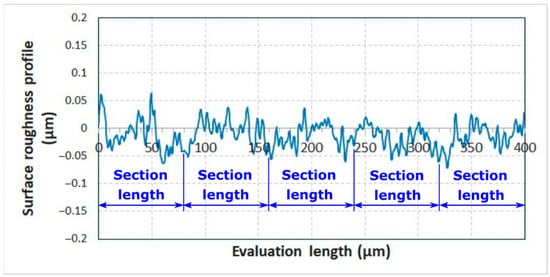
Figure A6.
Evaluated and section length of the surface roughness profile.
STN EN ISO 4287 [33] and ISO 21920-2 [38] expands the possibilities of surface evaluation by the fact that almost all parameters defined in it can be applied to the primary profile, roughness profile, and waviness profile. The relations for their calculation are the same, except they are applied to a different profile. When marking, these parameters are distinguished by the first character, e.g., arithmetic mean height of the absolute values Pa, of the roughness profile Ra, and the waviness profile Wa.
In this article, the arithmetic mean height of the roughness profile will be assessed and evaluated. The arithmetical mean height of the roughness profile—Ra is the arithmetic mean of the absolute values of the coordinates in the range of the basic length (Figure A7):
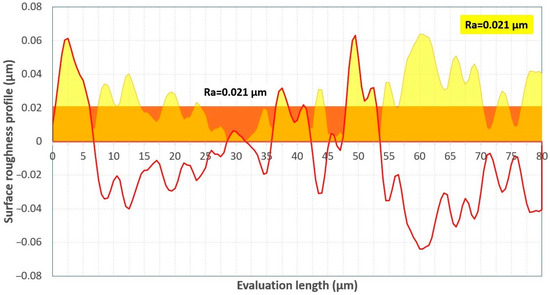
Figure A7.
Arithmetical mean deviation of the assessed roughness profile.
Appendix A.2. The Surface Roughness Standards
The basis for measuring surface roughness parameters and characteristics is the unit of length, defined in EN ISO standards and implemented by a set of micro-length etalons (line depth and line spacing), whose conventionally true value of line depth is measured by wavelength (on the device—interference microscopes), these etalons are for the area of surface roughness measurement—Primary Surface Roughness Standards.
Secondary Surface Roughness Standards (Figure A8) are sets of standards that embody the values of roughness parameters—Ra, Rz, Ry, and others. They are used to calibrate working gauges using the direct measurement method, where a measured standard of the same nominal value is directly calibrated using standard gauges.
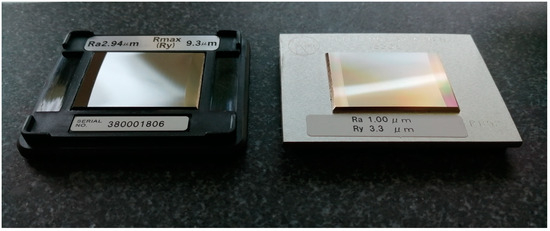
Figure A8.
Secondary Surface Roughness Standards.
The average distance of profile elements RSm can be determined as the average value of individual widths Xsi of profile elements’ surface roughness in the range of section length (Figure A9) according to the relationship:
where npe is the total number of profile elements.
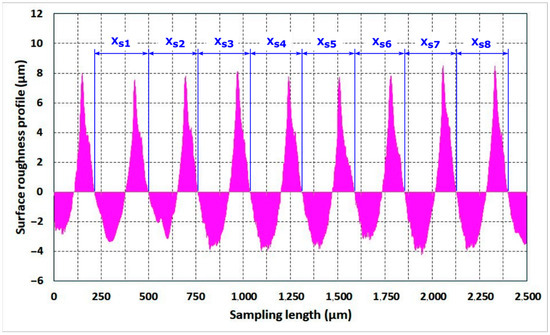
Figure A9.
Mean spacing of the profile elements RSm.
In the experimental part of this paper, we distinguish the so-called periodic and non-periodic surface roughness profiles.
Non-periodic surface roughness profiles arise mainly during finishing technologies such as grinding, polishing, and lapping, and with these methods, the Ra value reaches a maximum of 0.8 µm. Grinding technology is implemented in such a way that the material is removed by geometrically undefinable and randomly arranged cutting wedges on the grains of the abrasive material of the grinding disc, which separate the particles of the surface layers of the workpieces with abrasive grains stored in the binder, on the supporting tool or freely. Lapping is a finishing machining method that is used precisely to refine the surface. In principle, this technology belongs to grinding technologies. Lapping is the sanding of the surface of the product with a fine grinding abrasive material that is freely applied in a lapping liquid (e.g., oil, kerosene) or paste (e.g., paraffin, stearin) with dispersed fine abrasive that is applied to the lapping surface. During lapping, the peaks of unevenness are cut off with abrasive grains. Abrasive grain and fine abrasive can be understood as a cutting knife that has a random geometry and orientation, so the surfaces that arise after these types of machining have a non-periodic and randomly oriented character.
Periodic profiles of surface roughness arise during technological operations such as turning, milling, planing, which reach Ra values of more than 0.8 µm. With periodic profiles, there is a periodic movement of the tool along the surface of the component and the gradual removal of material, so the waviness of such a surface is more pronounced than with non-periodic profiles. Ra values greater than 25 µm are typical for the surfaces of parts that arise during casting and forging technologies.
When assessing the roughness of the surface, it is also necessary to take into account the direction of the unevenness of the surface, which is related to the machining method used. The unevenness of the profile can be parallel, perpendicular, oblique, or crossed with the contour line of the component. During some machining operations, circular irregularities or irregularities directed from the center of the component or unevenness are random in nature.
The ISO 21920-3 [39] standard introduces no distinction between periodic and non-periodic profiles compared to the edition of ISO 4288:1996 [34]. Nevertheless, the paper is focused on the analysis of the choice of cut-off filter for individual technologies, which were used to produce individual samples.
Appendix B
Non-Periodic Surface Roughness Profiles—Experiments
For the Lapping operation, samples (Figure A10) with nominal values Ra = 0.0415 µm, Ra = 0.083 µm, Ra = 0.166 µm, Ra = 0.408 µm were selected from the etalon samples set of surface roughness. On the course of the surface roughness profile for one of the samples, it can be seen how the number of profile unevenness increases according to the selected cut-off filter value Lc, where at the smallest value, too small an amount of unevenness of the surface roughness profile can be seen for Ra evaluation.


Figure A10.
Profile of surface roughness measured using different settings of the cut-off filter Lc for lapping—sample with value Ra = 0.408 µm.
Similar evaluations of Ra were carried out for other samples produced by the Lapping operation technology, and the obtained values are shown in Figure A11, where the [ISO] symbol indicates the cut-off value of the L-filter Lc recommended according to the ISO standard [33,34,35,36,37,38,39,40], and the red triangle with the OK (▼ ) symbol shows the value of Lc, which is optimal according to the performed experiments when the determined value of Ra is the closest nominal value of sample Ra. The displayed results show that the recommendations of the ISO standard are not in agreement with all experimental observations. These are mainly samples with larger Ra values.
) symbol shows the value of Lc, which is optimal according to the performed experiments when the determined value of Ra is the closest nominal value of sample Ra. The displayed results show that the recommendations of the ISO standard are not in agreement with all experimental observations. These are mainly samples with larger Ra values.
 ) symbol shows the value of Lc, which is optimal according to the performed experiments when the determined value of Ra is the closest nominal value of sample Ra. The displayed results show that the recommendations of the ISO standard are not in agreement with all experimental observations. These are mainly samples with larger Ra values.
) symbol shows the value of Lc, which is optimal according to the performed experiments when the determined value of Ra is the closest nominal value of sample Ra. The displayed results show that the recommendations of the ISO standard are not in agreement with all experimental observations. These are mainly samples with larger Ra values.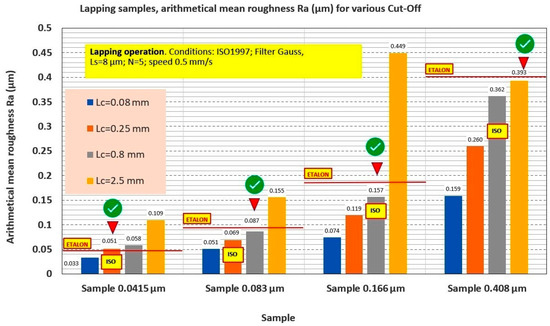
Figure A11.
Lapping—average value of Ra for different Lc cut-off filter settings.
For Face grinding operation, samples (Figure A12) with nominal values Ra = 0.11 µm, Ra = 0.176 µm, Ra = 0.384 µm, Ra = 0.72 µm, Ra = 1.46 µm, Ra = 3.42 µm were selected from the surface roughness sample book. The Ra = 0.384 µm sample is shown when measured for different values of the cut-off filter setting (Table 2). Even in this case, it can be seen with small values of the cut-off filter Lc that there is not a sufficient amount of unevenness of the surface roughness profile available for evaluation.
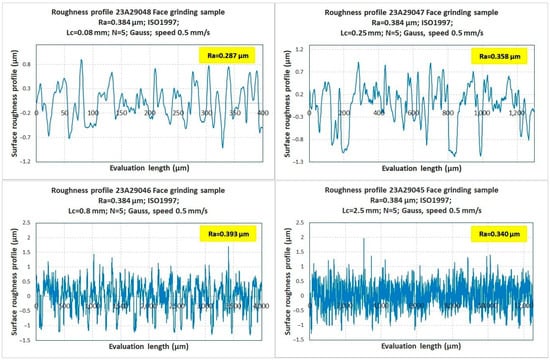
Figure A12.
Surface roughness profile measured using different settings of the cut-off filter Lc for face grinding for a sample with a nominal value of Ra = 0.384 µm.
Evaluations were carried out for other Face grinding operation samples and are shown in Figure A13, where it is also indicated which cut-off values of the Lc filter are recommended and which are optimal according to our experimental observations, where the cut-off value is marked using the symbol [ISO] of the filter Lc recommended according to the ISO standard [33,34,35,36,37,38,39,40], and the red triangle with the symbol OK (▼ ) shows the cut-off value of the filter Lc, which is optimal according to the conducted experiments, when the determined Ra value is closest to the nominal Ra value of the sample. The displayed results show that the recommendations of the ISO standard are also not in agreement with all experimental observations. These are mainly samples with larger nominal Ra values (Figure A13).
) shows the cut-off value of the filter Lc, which is optimal according to the conducted experiments, when the determined Ra value is closest to the nominal Ra value of the sample. The displayed results show that the recommendations of the ISO standard are also not in agreement with all experimental observations. These are mainly samples with larger nominal Ra values (Figure A13).
 ) shows the cut-off value of the filter Lc, which is optimal according to the conducted experiments, when the determined Ra value is closest to the nominal Ra value of the sample. The displayed results show that the recommendations of the ISO standard are also not in agreement with all experimental observations. These are mainly samples with larger nominal Ra values (Figure A13).
) shows the cut-off value of the filter Lc, which is optimal according to the conducted experiments, when the determined Ra value is closest to the nominal Ra value of the sample. The displayed results show that the recommendations of the ISO standard are also not in agreement with all experimental observations. These are mainly samples with larger nominal Ra values (Figure A13).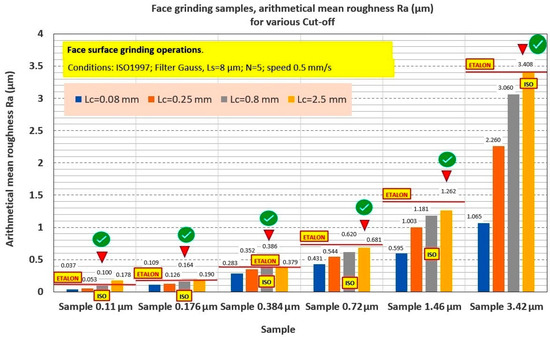
Figure A13.
Face grinding—average values of Ra for different settings of the cut-off filter Lc.
For the Peripheral grinding operation, samples (Figure A14) with nominal values Ra = 0.103 µm, Ra = 0.14 µm, Ra = 0.412 µm, Ra = 0.784 µm, Ra = 0.91 µm were selected from the etalon samples set of surface roughness. For the Ra = 0.392 µm sample, measurements at different cut-off filter values were evaluated (Figure A14).
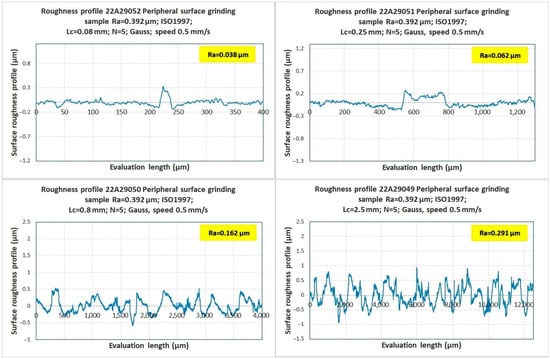
Figure A14.
Surface roughness profile measured using different settings of the cut-off filter Lc for peripheral grinding for a sample with a nominal value of Ra = 0.392 µm.
Even in this case, it can be seen with small values of the cut-off filter Lc that there is not a sufficient amount of unevenness of the surface roughness profile available for evaluation (Figure A14).
Evaluations were carried out for other peripheral grinding operation samples and are shown in Figure A15, where it is also indicated which cut-off values of the filter Lc are recommended and which are optimal according to our experimental observations, where the cut-off value is marked using the symbol [ISO] of the filter Lc recommended according to the ISO standard [33,34,35,36,37,38,39,40], and the red triangle with the symbol OK (▼ ) shows the cut-off value of the filter Lc, which is optimal according to the conducted experiments, when the determined value of Ra is closest to the nominal value of the sample. The displayed results show that the recommendations of the ISO standard are also not in agreement with all experimental observations. These are mainly samples with larger Ra values (Figure A15).
) shows the cut-off value of the filter Lc, which is optimal according to the conducted experiments, when the determined value of Ra is closest to the nominal value of the sample. The displayed results show that the recommendations of the ISO standard are also not in agreement with all experimental observations. These are mainly samples with larger Ra values (Figure A15).
 ) shows the cut-off value of the filter Lc, which is optimal according to the conducted experiments, when the determined value of Ra is closest to the nominal value of the sample. The displayed results show that the recommendations of the ISO standard are also not in agreement with all experimental observations. These are mainly samples with larger Ra values (Figure A15).
) shows the cut-off value of the filter Lc, which is optimal according to the conducted experiments, when the determined value of Ra is closest to the nominal value of the sample. The displayed results show that the recommendations of the ISO standard are also not in agreement with all experimental observations. These are mainly samples with larger Ra values (Figure A15).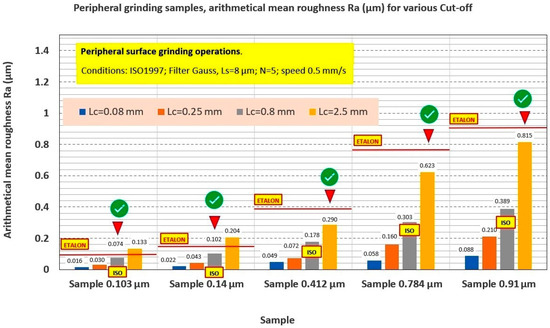
Figure A15.
Peripheral grinding—average values of Ra for different settings of the cut-off filter Lc.
Appendix C
Periodic Surface Roughness Profiles–Experiments
For milling with a slab mill cutter (Milling operation with slab mill cutter), a selected sample, measured at the same place but with different values of the cut-off filter Lc, is shown (Figure A16). It can be seen from the given graphic curves that for the cut-off filter Lc with the smallest value, its value is too small and therefore does not capture the actual value of the quantity Ra after evaluation. At other values, the periodic pattern characteristic of this technology is already visible. The effect of waviness is only slightly visible at the largest used value of the cut-off filter Lc = 2.5 mm.
For milling with a cylindrical cutter (Milling operation with slab mill cutter), samples with nominal values Ra = 1.52 µm were experimentally examined; 3.57 µm; 6.05 µm; 10.25 µm; 16.25 µm. The RSm values for all these samples measured at different settings of the cut-off filter Lc are shown in Figure A17, and it follows from them that the only suitably chosen value of the cut-off filter Lc is 2.5 mm. At the other values of the cut-off filter Lc, the values of RSm were outside the range of the instrument or could not be evaluated.
The Ra values for milling with a slab mill cutter (Milling operation with slab mill cutter) were determined for different values of the cut-off filter Lc and are in accordance with ISO recommendations (Figure A18).

Figure A16.
Surface roughness profile measured using different settings of the cut-off filter Lc for milling with a slab mill cutter (Milling operation with slab mill cutter) for a sample with a nominal value of Ra = 3.57 µm.
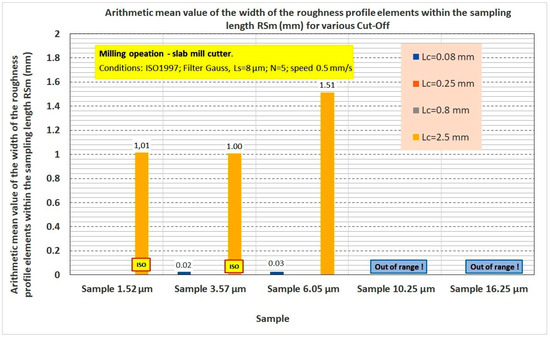
Figure A17.
Milling with a cylindrical cutter—average RSm values for different settings of the cut-off filter Lc.
For milling operation with a face mill cutter, a selected sample with a nominal value of Ra = 3.46 µm measured at the same place but with different values of the cut-off filter Lc is shown. From the contours of the surface roughness profile of the sample, it can be seen that the first two contours have a poorly chosen cut-off filter Lc and the contours do not capture a representative sample of the course characteristic of this type of technology. The other two surface roughness profile records already provide a surface roughness profile that can already be analyzed. In the last surface roughness profile, a slight influence of the waviness of the surface profile is already visible (Figure A19).
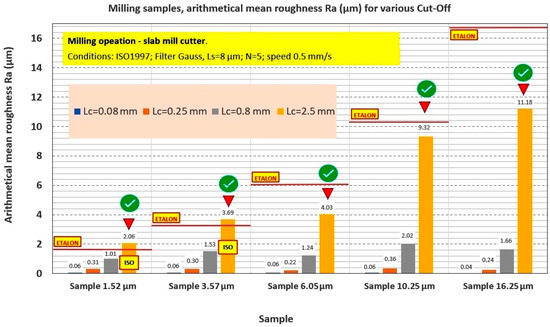
Figure A18.
Milling with a slab mill cutter—average values of Ra for different settings of the cut-off filter Lc.
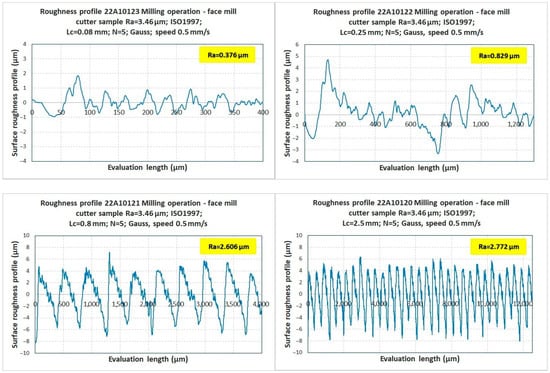
Figure A19.
Surface roughness profile measured using different settings of the cut-off filter Lc for face milling for a sample with a nominal value of Ra = 3.46 µm.
For milling operation with a face mill cutter, samples with nominal values Ra = 1.71 µm 3.46 µm; 6.17 µm; 11 µm; 19.25 µm were experimentally examined. The RSm values for all these samples determined at different settings of the cut-off filter Lc are shown in Figure A20, and from them, it follows that for samples Ra = 1.71 µm; 3.46 µm, RSm values are similar at Lc = 0.8 mm and at Lc = 0.25 mm. For other samples, the only appropriately chosen cut-off value of the Lc filter is 2.5 mm, and at other cut-off values of the Lc filter, the RSm values were very low or could not be evaluated (Figure A20).
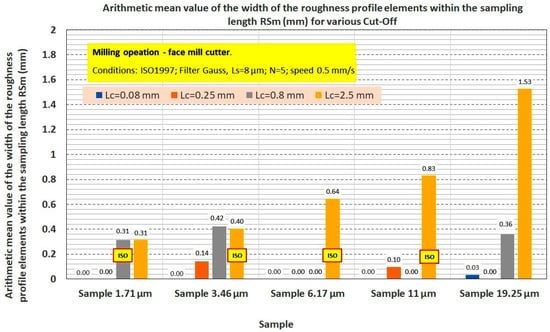
Figure A20.
Milling operation with face mill cutter—average RSm values for different settings of the cut-off filter Lc.
The Ra values for face milling were determined for different values of the cut-off filter Lc and are in accordance with ISO recommendations (Figure A21). For the 19.25 µm sample, the recommended filter cut-off value is Lc = 8 mm, which is not shown on the graph because the used surface tester does not have this setting available (Figure A21).
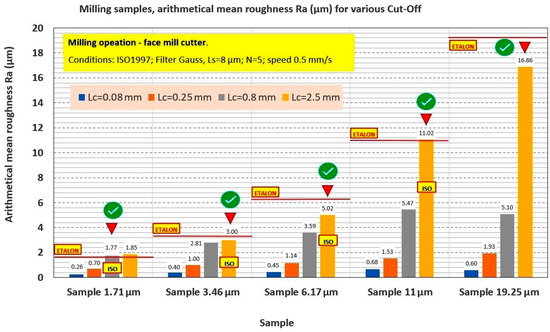
Figure A21.
Milling operation with face mill cutter—average Ra values for different settings of the cut-off filter Lc.
For turning, a sample with a nominal value of Ra = 2.78 µm is shown (Figure A22). With the first two values of the cut-off filter Lc, it is again visible that the sample does not correspond to the nature of the turning technology, and the cut-off filter parameter Lc is poorly chosen. In the case of a sample with a filter cut-off parameter Lc = 0.8 mm, the course of the surface roughness profile already corresponds to the technology of this sample, and the filter cut-off parameter Lc is appropriately chosen. In the last sample, the effect of waviness is already visible, so it is obvious that the cut-off filter parameter Lc is no longer appropriately chosen (Figure A22).
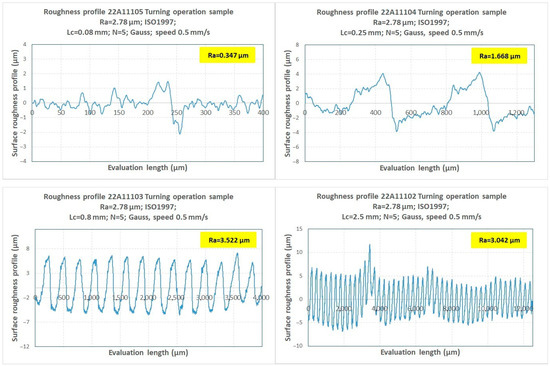
Figure A22.
Surface roughness profile measured using different settings of the cut-off filter Lc for the turning operation for a sample with a nominal value of Ra = 2.78 µm.
For the turning operation, samples (C8) with nominal values of Ra = 0.784 µm; 1.55 µm; 2.78 µm; 6.55 µm; 12.63 µm were experimentally examined. The RSm values for all these samples determined at different settings of the cut-off filter Lc are shown in Figure A23, and it follows from them that, apart from one sample, the RSm values are evaluated only for the cut-off filter values Lc = 0.8 mm and 2.5 mm and show approximately the same values.
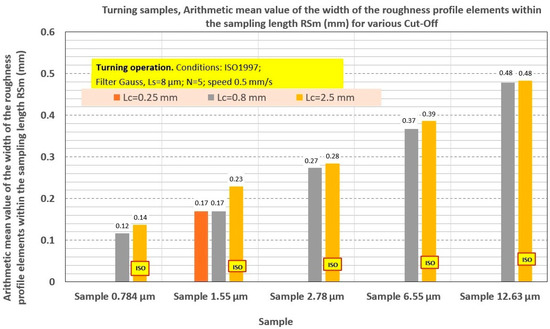
Figure A23.
Turning operation—average RSm values for different settings of the cut-off filter Lc.
The values of Ra for turning operation were determined for different values of the cut-off filter Lc and, except for one sample, they are not in accordance with ISO recommendations. However, this may be due to the uncertainty of the measurement because there are only small differences between the values that are optimal and the values at the settings recommended by the standard (Figure A24).
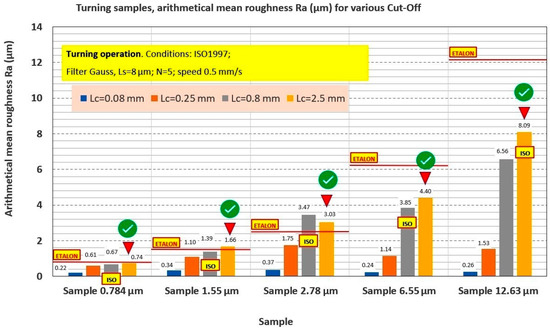
Figure A24.
Turning operation—average Ra values for different settings of the cut-off filter Lc.
For the planing operation, a sample with a nominal value of Ra = 3.04 µm is shown (Figure A25). With the first two values of the cut-off filter Lc, it is again visible that the sample does not correspond to the nature of the planing technology, and the cut-off filter parameter Lc is poorly chosen. In the case of a sample with a filter cut-off parameter Lc = 0.8 mm, the course of the surface roughness profile already corresponds to the technology of this sample, and the filter cut-off parameter Lc is appropriately chosen. In the last sample, the effect of waviness is already visible, so it is obvious that the cut-off filter parameter Lc is no longer appropriately chosen (Figure A25).
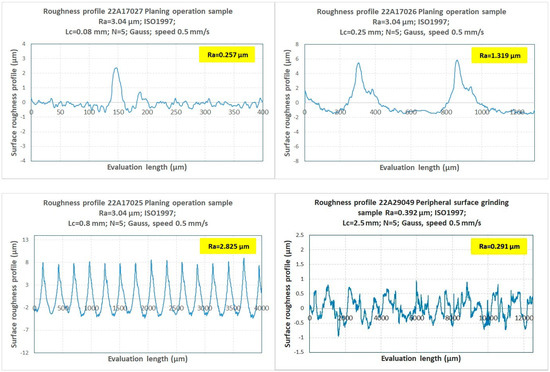
Figure A25.
Surface roughness profile measured using different settings of the cut-off filter Lc for the planing operation for a sample with a nominal value of Ra = 3.04 µm.
Samples with nominal values of Ra = 1.5 µm; 3.04 µm; 6.57 µm; 11.5 µm; 20.25 µm were experimentally examined for planing operation. The RSm values for all these samples determined at different settings of the cut-off filter Lc are shown in Figure A26, and it follows from them that, except for one sample, the RSm values are evaluated only for the cut-off filter values Lc = 0.8 mm and 2.5 mm and show approximately the same RSm values. For the sample with the largest value of Ra, the value RSm is determined only for cut-off filter values Lc = 2.5 mm; with other settings of the cut-off filter Lc, it was not possible to determine RSm (Figure A26).
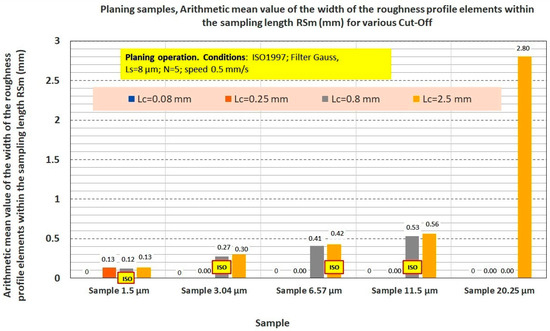
Figure A26.
Planing operation—average RSm values for different settings of the cut-off filter Lc.
The Ra values for the planing operation were determined for different values of the cut-off filter Lc and the first two samples are in accordance with ISO recommendations (Figure A27). The Ra values of other samples do not match the values determined for the cut-off filter parameters Lc recommended by the standard. However, this may be due to the uncertainty of the measurement because there are only small differences between the values that are optimal and the values at the settings recommended by the standard (Figure A27).
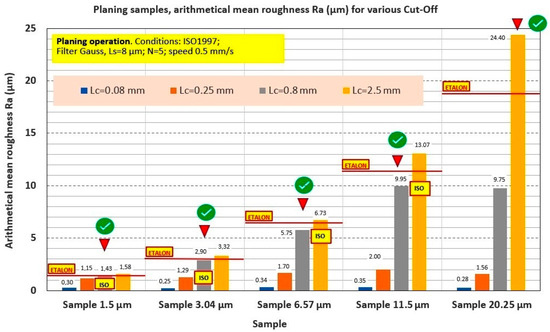
Figure A27.
Planing operation—average values of Ra for different settings of the cut-off filter Lc.
References
- Whitehouse, D.J. Surfaces and Their Measurement, 1st ed.; Butterworth-Heinemann: Oxford, UK, 2004; 432p, ISBN 9781903996607. [Google Scholar]
- Vorburger, T.V.; Rhee, H.G.; Renegar, T.B.; Song, J.F.; Zheng, A. Comparison of optical and stylus methods for measurement of surface texture. Int. J. Adv. Manuf. Technol. 2007, 33, 110–118. [Google Scholar] [CrossRef]
- Kumar, S.P.L. Measurement and uncertainty analysis of surface roughness and material removal rate in micro turning operation and process parameters optimization. Measurement 2019, 140, 538–547. [Google Scholar] [CrossRef]
- Beňo, J.; Maňková, I.; Vrabel, M.; Kottfer, D. Roughness measurement methodology for selection of tool inserts. Measurement 2013, 46, 582–592. [Google Scholar] [CrossRef]
- Davinci, M.A.; Parthasarathi, N.L.; Borah, U.; Albert, S.K. Effect of the tracing speed and span on roughness parameters determined by stylus type equipment. Measurement 2014, 48, 368–377. [Google Scholar] [CrossRef]
- Misumi, I.; Naoi, K.; Sugawara, K.; Gonda, S. Profile surface roughness measurement using metrological atomic force microscope and uncertainty evaluation. Measurement 2015, 73, 295–303. [Google Scholar] [CrossRef]
- Molnár, V. Minimization Method for 3D Surface Roughness Evaluation Area. Machines 2021, 9, 192. [Google Scholar] [CrossRef]
- Bazan, A.; Turek, P.; Przeszłowski, Ł. Assessment of InfiniteFocus system measurement errors in testing the accuracy of crown and tooth body model. J. Mech. Sci. Technol. 2021, 35, 1167–1176. [Google Scholar] [CrossRef]
- Bazan, A.; Turek, P.; Przeszłowski, Ł. Comparison of the contact and focus variation measurement methods in the process of surface topography evaluation of additively manufactured models with different geometry complexity. Surf. Topogr. Metrol. Prop. 2022, 10, 035021. [Google Scholar] [CrossRef]
- Płodzień, M.; Żyłka, Ł.; Sułkowicz, P.; Żak, K.; Wojciechowski, S. High-Performance Face Milling of 42CrMo4 Steel: Influence of Entering Angle on the Measured Surface Roughness, Cutting Force and Vibration Amplitude. Materials 2021, 14, 2196. [Google Scholar] [CrossRef]
- Bazan, A.; Turek, P.; Sułkowicz, P.; Przeszłowski, Ł.; Zakręcki, A. Influence of the Size of Measurement Area Determined by Smooth-Rough Crossover Scale and Mean Profile Element Spacing on Topography Parameters of Samples Produced with Additive Methods. Machines 2023, 11, 615. [Google Scholar] [CrossRef]
- Bhushan, B. Chapter: Surface Roughness Analysis and Measurement Techniques. In Modern Tribology Handbook, Two Volume Set, 1st ed.; CRC Press: Boca Raton, FL, USA, 2000; 1760p, ISBN 9780429126727. [Google Scholar] [CrossRef]
- Kreith, F. The Mechanical Engineering Handbook Series, 2nd ed.; CRC Press: New York, NY, USA, 2005; 2508p, ISBN 0-8493-0866-6. [Google Scholar]
- Webster, J.G.; Eren, H. Measurement, Instrumentation, and Sensors Handbook, 2nd ed.; CRC Press: Boca Raton, FL, USA, 2014; 1640p, ISBN 9781315217451. [Google Scholar] [CrossRef]
- Leach, R. The Measurement of Surface Texture Using Stylus Instruments; NPL National Physical Laboratory, HMSO: Teddington, UK, 2001. [Google Scholar]
- Poon, C.Y.; Bhushan, B. Comparison of surface roughness measurements by stylus profiler, AFM and non-contact optical profiler. Wear 1995, 190, 76–88. [Google Scholar] [CrossRef]
- Jester, W.; Klik, A. Soil surface roughness measurement—Methods, applicability, and surface representation. Catena 2005, 64, 174–192. [Google Scholar] [CrossRef]
- Stout, K.J. Surface roughness ~ measurement, interpretation and significance of data. Mater. Des. 1981, 2, 260–265. [Google Scholar] [CrossRef]
- Verheijen, E. A survey on roughness measurements. J. Sound Vib. 2006, 293, 784–794. [Google Scholar] [CrossRef]
- Chang, W.-R.; Kim, I.-J.; Manning, D.P.; Bunterngchit, Y. The role of surface roughness in the measurement of slipperiness. Ergonomics 2001, 44, 1200–1216. [Google Scholar] [CrossRef]
- Whitehouse, D.J. Surface Characterization and Roughness Measurement in Engineering. In Photomechanics; Rastogi, P.K., Ed.; Topics in Applied Physics; Springer: Berlin/Heidelberg, Germany, 2000; Volume 77. [Google Scholar] [CrossRef]
- Wieczorowski, M.; Cellary, A.; Majchrowski, R. The analysis of credibility and reproducibility of surface roughness measurement results. Wear 2010, 269, 480–484. [Google Scholar] [CrossRef]
- Farkas, G.; Drégelyi-Kiss, Á. Measurement uncertainty of surface roughness measurement. In Proceedings of the IOP Conference Series: Materials Science and Engineering, Volume 448, XXIII International Conference on Manufacturing (Manufacturing 2018), Kecskemét, Hungary, 7–8 June 2018; pp. 1–10. [Google Scholar] [CrossRef]
- Rodriguez, F.V.; Sukumaran, J.; Ando, M.; De Baets, P. Roughness measurement problems in tribological testing. In Proceedings of the Sustainable Construction and Design 2011 (SCAD), Ghent, Belgium, 16–17 February 2011; Laboratory Soete, Ghent University: Ghent, Belgium, 2011; Volume 2, pp. 115–121. [Google Scholar]
- Fedotkin, A.Y.; Akimchenko, I.O.; Tran, T.-H.; Shugurov, A.R.; Shesterikov, E.V.; Kozelskaya, A.I.; Rutkowski, S.; Tverdokhlebov, S.I. Improvement of the Surface Properties of Polyether Ether Ketone via Arc Evaporation for Biomedical Applications. Materials 2023, 16, 2990. [Google Scholar] [CrossRef]
- La, S.; Wang, C. Experimental and Numerical Calculation of the Friction Performance of a Concrete Surface. Materials 2023, 16, 2989. [Google Scholar] [CrossRef]
- Płodzień, M.; Żyłka, Ł.; Stoić, A. Modelling of the Face-Milling Process by Toroidal Cutter. Materials 2023, 16, 2829. [Google Scholar] [CrossRef]
- Kažukauskas, E.; Butkus, S.; Jukna, V.; Paipulas, D.; Sirutkaitis, V. Scanning Algorithm Optimization for Achieving Low-Roughness Surfaces Using Ultrashort Laser Pulses: A Comparative Study. Materials 2023, 16, 2788. [Google Scholar] [CrossRef]
- Xia, Y.; Lu, Y.; Yang, G.; Chen, C.; Hu, X.; Song, H.; Deng, L.; Wang, Y.; Yi, J.; Wang, B. Application of Nano-Crystalline Diamond in Tribology. Materials 2023, 16, 2710. [Google Scholar] [CrossRef] [PubMed]
- Podulka, P.; Macek, W.; Branco, R.; Nejad, R.M. Reduction in Errors in Roughness Evaluation with an Accurate Definition of the S-L Surface. Materials 2023, 16, 1865. [Google Scholar] [CrossRef] [PubMed]
- Smak, K.; Szablewski, P.; Legutko, S.; Krawczyk, B.; Miko, E. Investigation of the Influence of Anti-Wear Coatings on the Surface Quality and Dimensional Accuracy during Finish Turning of the Inconel 718 Alloy. Materials 2023, 16, 715. [Google Scholar] [CrossRef]
- Carek, A.; Slokar Benić, L.; Komar, D.; Krebelj, E. Roughness of the Surface of Zirconia Reinforced Lithium Disilicate Ceramic Treated by Different Procedures. Materials 2023, 16, 265. [Google Scholar] [CrossRef]
- ISO 4287:1997; Geometrical Product Specifications (GPS)—Surface Texture: Profile Method—Terms, Definitions and Surface Texture Parameters. 1st ed. International Organization for Standardization: Geneve, Switzerland, 1 April 1997.
- ISO 4288: 1996; Geometrical Product Specifications (GPS)—Surface Texture: Profile Method—Rules and Procedures for the Assessment of Surface Texture. Edition DIN EN ISO 4288; European Committee for Standardization: Brussels, Belgium, April 1998.
- ISO 3274: 1996; Geometrical Product Specifications (GPS)—Surface Texture: Profile Method—Nominal Characteristic of Contact (Stylus) Instruments. European Committee for Standardization: Brussels, Belgium, December 1996.
- ISO 5436-1:2000; Geometrical Product Specifications (GPS)—Surface Texture: Profile Method; Measurement Standards—Part 1: Material Measures. European Committee for Standardization: Brussels, Belgium, March 2000.
- ISO 21920-1:2021; Geometrical Product Specifications (GPS)—Surface Texture: Profile—Part 1: Indication of Surface Texture. European Committee for Standardization: Brussels, Belgium, December 2021.
- ISO 21920-2:2021; Geometrical Product Specifications (GPS)—Surface Texture: Profile—Part 2: Terms, Definitions and Surface Texture Parameters. European Committee for Standardization: Brussels, Belgium, December 2021.
- ISO 21920-3:2021; Geometrical Product Specifications (GPS)—Surface Texture: Profile—Part 3: Specification Operators. European Committee for Standardization: Brussels, Belgium, December 2021.
- ISO 11562:1996; Geometrical Product Specifications (GPS)—Surface Texture: Profile Method—Metrological Characteristics of Phase Correct Filters. European Committee for Standardization: Brussels, Belgium, December 1996.
- Semyon, G. Rabinovich: Measurement Errors and Uncertainties. Theory and Practice, 3rd ed.; Springer: New York, NY, USA, 2005; p. XII. 308p, ISBN 978-0-387-25358-9/978-0-387-29143-7. [Google Scholar]
- Semyon, G. Rabinovich: Accuracy of single measurements. Accredit. Qual. Assur. 2007, 12, 419–424. [Google Scholar]
- Taylor, B.N.; Kuyatt, C.E. Guidelines for Evaluating and Expressing the Uncertainty of NIST Measurement Results; NIST Technical Note 1297; US Department of Commerce, Technology Administration, National Institute of Standards and Technology: Gaithersburg, MD, USA, 1994.
- Taylor, J.R. An Introduction to Error Analysis: The Study of Uncertainties in Physical Measurements, 2nd ed.; University Science Books: Herndon, VA, USA, 1 August 1996; 327p, ISBN 9780935702750. [Google Scholar]
- Mohajan, H. Two Criteria for Good Measurements in Research: Validity and Reliability. Ann. Spiru Haret Univ. 2017, 17, 58–82. Available online: https://mpra.ub.uni-muenchen.de/83458/MPRA (accessed on 8 April 2023). [CrossRef]
- EA-4/02 1999; Expression of the Uncertainty of Measurement in Calibration. European Co-Operation Accreditation Publication Reference: Brussels, Belgium, December 1999.
- JCGM 100 2008; JCGM 100—Evaluation of Measurement Data—Guide to the Expression of Uncertainty in Measurement (ISO/IEC Guide 98-3). 1st ed. ISO: Geneva, Switzerland, September 2008. Available online: http://www.iso.org/sites/JCGM/GUM-JCGM100.htm (accessed on 8 April 2023).
- JCGM 104 2009; Evaluation of Measurement Data—An introduction to the “Guide to the Expression of Uncertainty in Measurement” (ISO/IEC Guide 98-1). 1st ed. ISO: Geneva, Switzerland, July 2009. Available online: http://www.bipm.org/en/publications/guides/gum_print.html (accessed on 8 April 2023).
- JCGM 200—International Vocabulary of Metrology—Basic and General Concepts and Associated Terms (VIM) 3rd Edition (2008 Version with Minor Corrections). © JCGM 2012. Available online: http://www.iso.org/sites/JCGM/VIM-JCGM200.htm (accessed on 8 April 2023).
- JIS B 0601-1982; Geometrical Product Specifications (GPS)—Surface Texture: Profile Method—Terms, Definitions and Surface Texture Parameters. 1982 Edition; Japanese Industrial Standards Committee Standards Board, Japanese Standards Association (JSA): Tokyo, Japan, 15 June 1982.
- JIS B 0601: 1994; Geometrical Product Specifications (GPS)—Surface Texture: Profile Method—Terms, Definitions and Surface Texture Parameters. 1994 Edition; Japanese Industrial Standards Committee Standards Board, Japanese Standards Association (JSA): Tokyo, Japan, 1 January 1994.
- JIS B 0601: 2001; Geometrical Product Specifications (GPS)—Surface Texture: Profile Method—Terms, Definitions and Surface Texture Parameters. Japanese Industrial Standards Committee Standards Board, Japanese Standards Association (JSA): Tokyo, Japan, 1 January 2001.
- JIS B 0601: 2010; Geometrical Product Specifications (GPS)—Surface Texture: Profile Method—Terms, Definitions and Surface Texture Parameters. 2010 Edition; Japanese Industrial Standards Committee Standards Board, Japanese Standards Association (JSA): Tokyo, Japan, 1 October 2010.
- JIS B 0601:2013; Geometrical Product Specifications (GPS)—Surface Texture: Profile Method—Terms, Definitions and Surface Texture Parameters. 2013 Edition; Japanese Industrial Standards Committee Standards Board, Japanese Standards Association (JSA): Tokyo, Japan, 1 January 2013.
- JIS B 0601: 2022; Geometrical Product Specifications (GPS)—Surface Texture: Profile Method—Terms, Definitions and Surface Texture Parameters. 2022 Edition; Japanese Industrial Standards Committee Standards Board, Japanese Standards Association (JSA): Tokyo, Japan, 20 October 2022.
- JIS B0632: 2001; Geometrical Product Specification (GPS)—Surface Texture: Profile Method—Metrological Characteristics of Phase Correct Filters. 2001 Edition; Japanese Industrial Standards Committee Standards Board, Japanese Standards Association (JSA): Tokyo, Japan, 1 January 2001.
- JIS B 0651:2001; Geometrical Product Specification (GPS)—Surface Texture: Profile Method—Nominal Characteristics of Contact (Stylus) Instruments. 2001 Edition; Japanese Industrial Standards Committee Standards Board, Japanese Standards Association (JSA): Tokyo, Japan, 1 January 2001.
- JIS B 0610:2001; Geometrical Product Specification (GPS)—Surface Texture: Profile Method—Definitions and Designation of Rolling Circle Waviness. 2001 Edition; Japanese Industrial Standards Committee Standards Board, Japanese Standards Association (JSA): Tokyo, Japan, 22 January 2001.
- ANSI B46.1-1995; Surface Texture (Roughness, Waviness, Lay). ASME International (ASME): New York, NY, USA, January 1995.
- ANSI B46.1-2002; Surface Texture (Roughness, Waviness, Lay). ASME International (ASME): New York, NY, USA, January 2002.
- ANSI B46.1-2009; Surface Texture (Roughness, Waviness, Lay). ASME International (ASME): New York, NY, USA, January 2009.
- ASME B46.1-2019; Surface Texture (Roughness, Waviness, Lay). ASME International (ASME): New York, NY, USA, January 2019.
- VDA 2005; Geometrical Product Specifications Technical Drawings—Specification of Surface Texture. Verband Der Automobilindustrie E.V. (VDA): Berlin, Germany, February 2007.
- VDA 2006; Geometrical Product Specifications—Surface Texture—Rules and Procedures for The Assessment of Surface Texture. Verband Der Automobilindustrie E.V. (VDA): Berlin, Germany, July 2003.
- VDA 2007; Geometrical Product Specifications—Surface Texture—Definitions and Characteristic Values of The Dominant Waviness. Verband Der Automobilindustrie E.V. (VDA): Berlin, Germany, 1 February 2007.
- Álló, Š.; Kročko, V.; Korenko, M.; Andrássyová, Z.; Földešiová, D. Effect of chemical degreasing on corrosion stability of components in automobile industry. Adv. Mater. Res. 2013, 801, 19–23. [Google Scholar] [CrossRef]
- Bujna, M.; Prístavka, M.; Dostál, P.; Korenko, M.; Kadnár, M. Influence of Roughness on Quality Molybdenum Deposit Layer by Thermal Spraying. Acta Univ. Agric. Silvic. Mendel. Brun. 2016, 64, 9–14. [Google Scholar] [CrossRef]
- Duplak, J.; Duplakova, D.; Zajac, J. Research on Roughness and Microhardness of C45 Material Using High-Speed Machining. Appl. Sci. 2023, 13, 7851. [Google Scholar] [CrossRef]
- Krenicky, T.; Nikitin, Y.; Božek, P. Model-Based Design of Induction Motor Control System in MATLAB. Appl. Sci. 2022, 12, 11957. [Google Scholar] [CrossRef]
- Obaton, A.-F.; Fain, J.; Meinel, D.; Tsamos, A.; Léonard, F.; Lécuelle, B.; Djemaï, M. In Vivo Bone Progression in and around Lattice Implants Additively Manufactured with a New Titanium Alloy. Appl. Sci. 2023, 13, 7282. [Google Scholar] [CrossRef]
- Song, X.; Ke, F.; Zhu, K.; Ren, Y.; Zhou, J.; Li, W. Study on Preparation and Processing Properties of Mechano-Chemical Micro-Grinding Tools. Appl. Sci. 2023, 13, 6599. [Google Scholar] [CrossRef]
- Gradov, O.M. Optimization of Ultrasonic Powder Coatings on the Surface of Treated Materials. Appl. Sci. 2023, 13, 6034. [Google Scholar] [CrossRef]
- Khan, A.A.; Abdullah Alkhureif, A.; Bautista, L.S.J.; Alsunbul, H.; Vellappally, S. Peroxide-Free Bleaching Gel: Effect on the Surface and Mechanical Properties of Nano- and Micro-Hybrid Restorative Composite Materials. Appl. Sci. 2023, 13, 5935. [Google Scholar] [CrossRef]
- Ružbarský, J. The Difficulty of Measuring the Roughness of Glossy Surfaces Using the Triangulation Principle. Appl. Sci. 2023, 13, 5155. [Google Scholar] [CrossRef]
- Zhao, W.; Gao, Y.; Ren, X.; Lu, K.; Yang, Y. Dynamic Characteristics Analysis of a Rod Fastening Rotor System Considering Contact Roughness. Appl. Sci. 2023, 13, 5009. [Google Scholar] [CrossRef]
- Balonji, S.; Tartibu, L.K.; Okokpujie, I.P. Prediction Analysis of Surface Roughness of Aluminum Al6061 in End Milling CNC Machine Using Soft Computing Techniques. Appl. Sci. 2023, 13, 4147. [Google Scholar] [CrossRef]
- Kong, C.; Xu, Y.; Li, Z.; Zhang, C.; Li, T.; Macleod, I.; Jiang, X.; Tang, D.; Lu, J. A Multivariate Local Descriptor Registration Method for Surface Topography Evaluation. Appl. Sci. 2023, 13, 3311. [Google Scholar] [CrossRef]
- Ružbarský, J.; Gašpár, Š. Analysis of Selected Production Parameters for the Quality of Pressure Castings as a Tool to Increase Competitiveness. Appl. Sci. 2023, 13, 8098. [Google Scholar] [CrossRef]
- Krenicky, T.; Olejarova, S.; Servatka, M. Assessment of the Influence of Selected Technological Parameters on the Morphology Parameters of the Cutting Surfaces of the Hardox 500 Material Cut by Abrasive Water Jet Technology. Materials 2022, 15, 1381. [Google Scholar] [CrossRef]
- Gulyaev, P.; Krenicky, T.; Shelkovnikov, E.; Korshunov, A. Particle and Particle Agglomerate Size Monitoring by Scanning Probe Microscope. Appl. Sci. 2022, 12, 2183. [Google Scholar] [CrossRef]
- Sinčák, P.J.; Virgala, I.; Kelemen, M.; Prada, E.; Bobovský, Z.; Kot, T. Chimney Sweeping Robot Based on a Pneumatic Actuator. Appl. Sci. 2021, 11, 4872. [Google Scholar] [CrossRef]
- Kelemenová, T.; Dovica, M.; Božek, P.; Koláriková, I.; Benedik, O.; Virgala, I.; Prada, E.; Miková, L.; Kot, T.; Kelemen, M. Specific Problems in Measurement of Coefficient of Friction Using Variable Incidence Tribometer. Symmetry 2020, 12, 1235. [Google Scholar] [CrossRef]
- Miková, Ľ.; Prada, E.; Kelemen, M.; Krys, V.; Mykhailyshyn, R.; Sinčák, P.J.; Merva, T.; Leštach, L. Upgrade of Biaxial Mechatronic Testing Machine for Cruciform Specimens and Verification by FEM Analysis. Machines 2022, 10, 916. [Google Scholar] [CrossRef]
- Hroncova, D.; Sincak, P.J.; Merva, T.; Mykhailyshyn, R. Robot Trajectory Planning. MM Sci. J. 2022, 2022, 6098–6108. [Google Scholar] [CrossRef]
- Mykhailyshyn, R.; Duchoň, F.; Virgala, I.; Sinčák, P.J.; Fey, A.M. Optimization of Outer Diameter Bernoulli Gripper with Cylindrical Nozzle. Machines 2023, 11, 667. [Google Scholar] [CrossRef]
Disclaimer/Publisher’s Note: The statements, opinions and data contained in all publications are solely those of the individual author(s) and contributor(s) and not of MDPI and/or the editor(s). MDPI and/or the editor(s) disclaim responsibility for any injury to people or property resulting from any ideas, methods, instructions or products referred to in the content. |
© 2023 by the authors. Licensee MDPI, Basel, Switzerland. This article is an open access article distributed under the terms and conditions of the Creative Commons Attribution (CC BY) license (https://creativecommons.org/licenses/by/4.0/).